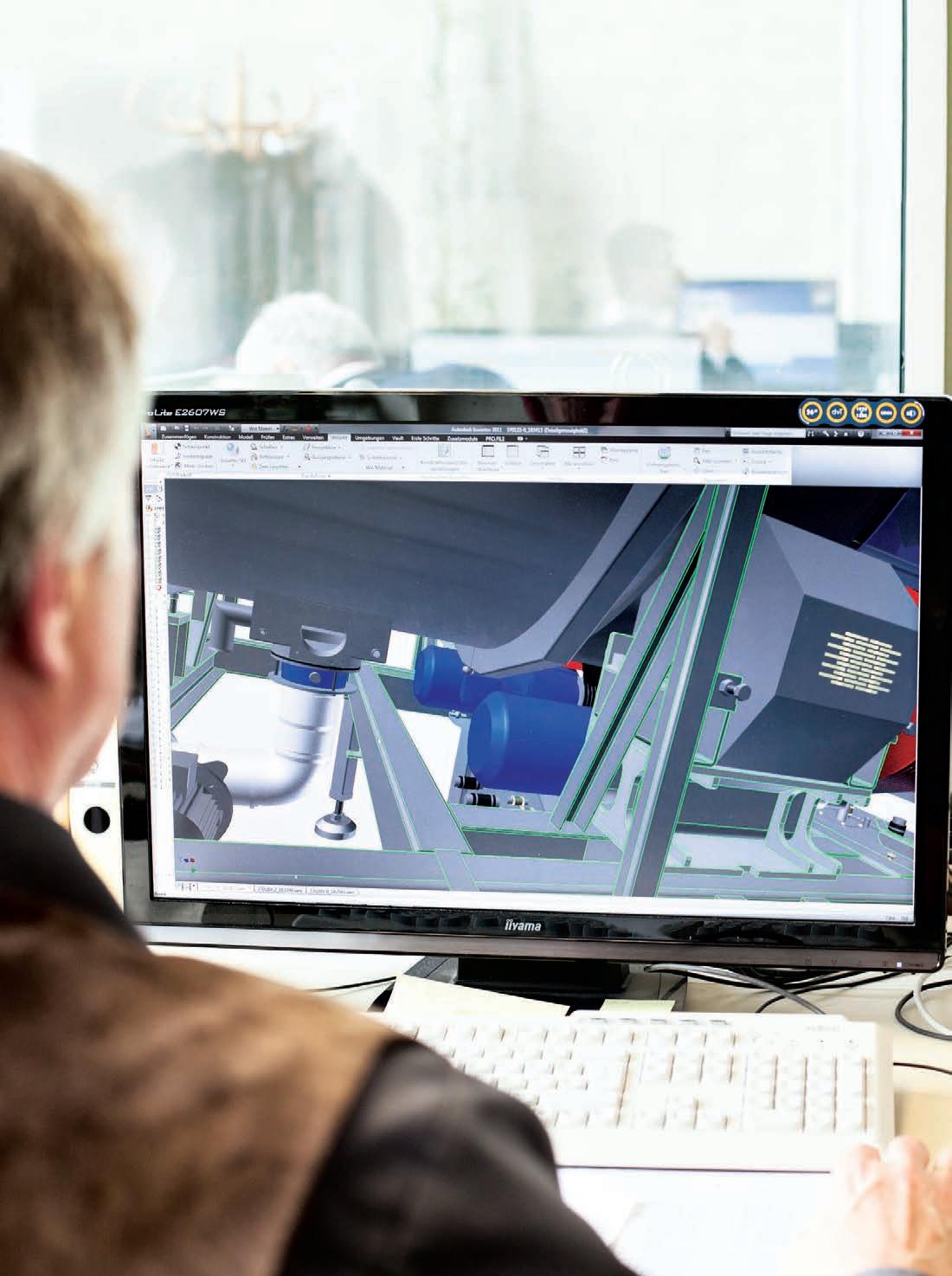Edison Laundry Corp. purchases Marriott NJ laundry facility
EDISON, N.J. — Marriott International, worldwide operator and franchisor of hotels, has agreed to sell the assets of its N.J. Marriott Textile Services laundry facility here in Edison, the company reports.
The Bethesda, Md., company said in a statement that the purchaser, Edison Laundry Corp., will operate as Marriott International’s principal laundry supplier for the greater New York/New Jersey market under a multiyear contract.

Terms of the transaction were not announced.
Walt Disney World begins construction on new laundry plant
LAKE BUENA VISTA, Fla. — Walt Disney World Resort has begun construction on a 130,000-squarefoot laundry facility due to open in 2015.
The company says the facility will “support the expansion of resort hotel rooms and accommodate adjustments in the type of linens used at the resort hotels.” It will be the fourth and most “technologically advanced” Disney laundry.
Choosing chemical wash formulas: Accounting for changing variables key to good results
BY THERESA BOEHL, EDITOR
CHICAGO — “The only constant is change,” the old saying goes. Laundry operators know this to be true, and when it comes to the elements that affect chemical wash formulas, change is especially ever-present.
While the four basic variables for achieving good cleaning results—processing time, water temperature, chemical action and the washer’s mechanical action—are mainstays, even they must make room for additional factors, both internal and external to an operation.
Finding the right mix of chemicals, resources and procedures is often a combination of careful orchestration and constant vigilance.
To help uncover the most important factors to consider when choosing a chemical wash formula, American Laundry News polled several vendors about changing chemical composition, new health and safety initiatives, and ways that a facility’s management and personnel can help or hinder wash-formula selection.
AN EVER-CHANGING WORLD
Jason Lang, director of RD&E Textile Care Division at Ecolab, says recent developments in laundry chemistry have been driven by scarce
resources and restricted capacities, as customers are looking for formulas that use less water, fewer rinses and lower temperatures.
“Basically, wash formulas have changed to react to other changes in the market,” says
Annual ALM conference aims to tackle changing needs of industry
The association’s biennial golf tournament on the morning of June 9 will benefit the ALM scholarship fund.
Around 400 new jobs will be created with the facility’s opening, with around 200 of them slated for roles like linen handlers, maintenance personnel and managers, according to the company.
RICHMOND, Ky. — Promoting education as a way to tackle the changing needs of the industry, the Association for Linen Management (ALM) will host its annual conference June 9-11 at the Saddlebrook Resort near Tampa, Fla.
Conference sessions will focus on a variety of issues of interest to laundry/linen managers, such as customer relationships, managing staff, mergers and acquisitions in healthcare, new business opportunities and lean processing, to name just a few.
Awards for the 2014 Heywood Wiley Manager of the Year and Allied Tradesperson of the Year will be presented at a banquet and reception, which closes the conference on the night of June 11. Also planned is a presentation highlighting the association’s 75-year history.
The agenda includes:
Engineering, will present Making the Case for Lean Processing



• 1-2:15 p.m. — Educational breakouts will feature Paul Fayad, of Positive Leader, as he discusses Succession Planning, and a speaker to be announced presenting Medicare Bundled Payments (BCPI Initiative) and Industry Impact.
ALN
ALM says attendees will gain a greater understanding of healthcare reform, streamlining operations and ways to grow revenue.
Monday, June 9
• 10-11:30 a.m. — In an educational breakout session, David Bernstein, Turn-Key
• 2:30-4 p.m. — In the day’s general session, Brent Petty, CMRP, Wellmont Health System, will discuss The Affordable Healthcare Act and its impact on the
Panel of Experts
Group offers tips for navigating staff communication issues.

McGuire VA Plant Revamp
Virginia plant becomes first steamless laundry in a federal facility thanks to $8 million-plus renovation.
OPL 101:






Wash Formulas & Equipment
Bill Brooks: Two most important factors for running an effective laundry are its equipment and wash chemistry.
MAY 2014
Late News
www.americanlaundrynews.com Volume 40, Number 5
The Newspaper of Record for Laundry & Linen Management
[10] [
] [16]
Steve Tinker, senior vice president, Research & Development, Marketing at Gurtler Industries. He lists polyester fabrics and new washing
INSIDE
15
See WASH on Page 9 See ALM on Page 19
(Photo: ©iStockphoto/justinkendrajustinkendra)
CHICAGO — Maintaining a clean facility overall is a top priority for the majority of laundry/linen operators polled in April’s American Laundry News Your Views survey.
A whopping 83.3% of respondents say they perform all or most of these cleaning tasks every day: sweeping/mopping floors; disinfecting soil-sort conveyors/chutes; disinfecting washers; cleaning exhaust fans; wiping/vacuuming/blowing down equipment; and cleaning lint filters.
“We gather other people’s dirt for a living,” says one laundry/linen operator. “If we do not clean, we will drown in it.”
Of those who do not complete all of the listed tasks every day, cleaning lint filters was a top priority for 7.6% of operators, while wiping/ vacuuming/blowing down equipment was the most important cleaning task for 4.6%. The remaining respondents, representing equal shares of 1.5%, had their priorities spread among sweeping/mopping floors, disinfecting soil-sort conveyors/chutes and cleaning exhaust fans.
Less than half of the respondents—46.3%—post cleaning/maintenance schedules prominently in their facilities. For most respondents (73.2%), training on cleaning tasks is part of a new employee’s orientation.
“With the elevated rate of HAI [healthcare-associated infections] across the country and more stringent protocols in all aspects, cleaning and training play a greater role than ever,” says one laundry/linen operator.
So what is the best way to ensure that staff members complete assigned cleaning tasks? Nearly 45% believe it’s best accomplished by putting a team member in charge of confirming completion.
A smaller but still significant percentage (24.6%) say that demonstrating how cleaning benefits a facility is the most effective method. Others point to frequent training (10.8%) and threats of discipline (4.6%), while 15.4% listed “other” methods, such as using detailed check-off sheets, having daily discussions with staff, and having a designated employee do cleaning and repairs, to name just a few.
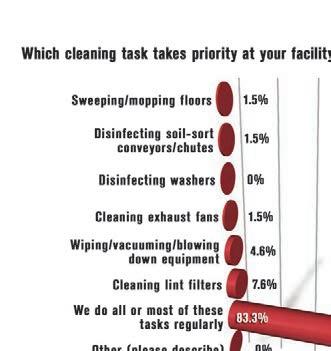
When asked for the primary reason that regular cleaning might not occur as needed, more than 50% of respondents say that timely production takes priority. Roughly 15% pointed to having a lack of time to complete the tasks, while almost 11% say having no team member in charge of tasks leads to a cleaning lapse.

For 7.7%, problems with cleaning arise when employees don’t understand how it benefits a facility, and a little more than 6% say that high turnover makes it hard to keep staff properly trained. A small percentage (6.2%) listed other reasons, such as equipment breakdowns or falsified documentation, to name a few.
Just how important is cleanliness in maintaining a safe working environment? Almost 88% of respondents say it’s “extremely important,” and 10.6% deem it “somewhat important.” A small percentage (1.5%) disagree, saying it is “not at all important.”
While the Your Views survey presents a snapshot of readers’ viewpoints at a particular moment, it should not be considered scientific.
Subscribers to American Laundry News e-mails are invited to take the industry survey anonymously online each month. All managers and administrators of institutional/OPL, cooperative, commercial and industrial laundries are encouraged to participate, as a greater number of responses will help to better define operator opinions and industry trends.
AmeriPride acquires Wood City Laundry
MINNEAPOLIS — AmeriPride Services recently acquired Cloquet, Minn.-based Wood City Laundry, the company reports.
AmeriPride says it began supporting Wood City Laundry in late February after a fire, and began fully servicing the company’s customer accounts in early
March out of its Hibbing, Minn., branch and Duluth, Minn., service center under the leadership of Dave Hardy, general manager.
John Sutherland, AmeriPride senior vice president of operations, calls the acquisition a “nice fit” for the business and its new customers. ALN
Publisher
Charles Thompson
Phone: 312-361-1680
E-Mail: cthompson@ americantrademagazines.com

Editorial Director
Bruce Beggs
Phone: 312-361-1683
E-Mail: bbeggs@ americantrademagazines.com
Digital Media Director
Nathan Frerichs
Phone: 312-361-1681
E-Mail: nfrerichs@ americantrademagazines.com
Editor
Theresa Boehl
Phone: 708-280-1750
E-Mail: tboehl@ americantrademagazines.com
Production Manager
Roger Napiwocki
Contributing Editor Jean Teller
Editorial Assistant Carlo Calma
Advertising Sales
National Sales Director

Donald Feinstein
Phone: 312-361-1682
E-Mail: dfeinstein@ americantrademagazines.com
Office Information
Main Phone: 312-361-1700 Fax: 312-361-1685
Subscriptions
630-739-0900 x100 www.americanlaundrynews.com
American Laundry News (ISSN 1091-9201) is published monthly. Subscription prices, payment in advance: U.S. 1 year $39.00; 2 years $73.00. Foreign, 1 year $89.00; 2 years $166.00. Single copies: U.S. $7.00; Foreign $14.00. Published by American Trade Magazines LLC, 566 West Lake Street, Suite 420, Chicago, IL 60661. Periodicals postage paid at Chicago, IL, and at additional mailing offices.
POSTMASTER, Send changes of address and form 3579 to American Laundry News, Subscription Dept., 440 Quadrangle Drive, Suite E, Bolingbrook, IL 60440. Volume 40, number 5. Editorial, executive and advertising offices are at 566 West Lake Street, Suite 420, Chicago, IL 60661. Charles Thompson, President and Publisher. American Laundry News is distributed selectively to qualified laundry and linen management and distributors in the United States. No material appearing in American Laundry News may be reprinted without written permission. The publisher reserves the right to reject any advertising for any reason.
© Copyright AMERICAN TRADE MAGAZINES LLC, 2014. Printed in U.S.A.

MEMBERSHIPS
2 MAY 2014 | AMERICAN LAUNDRY NEWS www.AmericanLaundryNews.com
Association for Linen Management
INSIDE: May 2014 • Vol. 40 | No. 5 [6] Tunnel Washers: The Answer to Rising Costs? How is a tunnel different from open-pocket washers, and how can an operation benefit from this technology? [8] Tools of the Trade [10] Panel of Experts: Language and Communication “In what ways could language differences impact our laundry operation?” [13] Preview of TRSA Safety Summit The third annual event will present strategies for achieving the best possible safety performance levels [16] OPL 101: Wash Formulas and Equipment Equipment and chemistry work hand-in-hand to help laundries operate at peak performance levels [18] Trade Ticker [19] Calendar Survey:
facility no-brainer for most laundry managers
ALN
Maintaining clean



Polar Vortex no more
ihope this issue of American Laundry News finds you exchanging your parkas and thermals for more lightweight threads and, if you’re like my wife, opentoed shoes (just not in the plant).
It was a brutally harsh winter here in Chicago, as it was for most of the continental United States, but spring—not just the March date on the calendar, the honestto-goodness season of life—is finally here.
This brings to mind the need for spring cleaning, but I think the results of this month’s Your Views survey (story on page 2) demon-
strate that cleaning is pretty much done routinely in the laundry industry, and that an extensive
new-season effort isn’t necessary.
Sweeping/mopping, disinfecting washers, and cleaning exhaust fans/lint filters are among tasks completed daily by nearly 84% of respondents. A near identical percentage believe that cleanliness is “extremely important” in maintaining a safe working environment. Perhaps next month’s TRSA Safety Summit will touch on the topic.
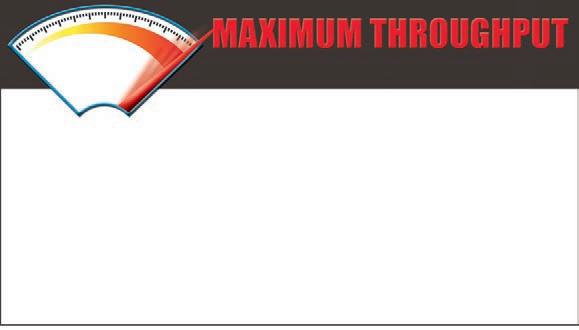
In whatever state you find your plant these days—a clean, safe one is my wish—I hope the arrival of spring has ushered in a sunny future for you and your staff. ALN
Boehl named editor of American Laundry News


CHICAGO — American Trade Magazines LLC, the parent company of American Laundry News, has hired Theresa M. Boehl as the magazine’s new editor, effective immediately. She reports to Editorial Director Bruce Beggs, who has edited American Laundry News for the past 14 years.
While Boehl (pronounced “bale”) assumes day-to-day responsibility for the magazine, Beggs will continue to oversee the publication while also directing sister publications American Coin-Op and American Drycleaner and other editorial projects for American Trade Magazines.
Most recently, Boehl was editor of Cold Facts magazine, a publication of the Cryogenic Society of America in Oak Park, Ill. Cryogenics is a branch of physics and engineering that involves extremely low temperatures.
Boehl joined the bimonthly magazine as editorial assistant in 2007 and worked her way up to editor, writing and editing stories; interviewing influential scientists, engineers and government officials; designing page layouts; and representing the publication at national and international conferences and meetings.
She also has online editing experience, having served a year as staff writer and managing editor of LoganSquarist.com, a hyperlocal news website serving the Logan Square neighborhood of Chicago.
Boehl has a bachelor of arts degree in linguistics from the University of Michigan in Ann Arbor; a certificate in technical communication from the College of DuPage, Glen Ellyn, Ill.; and a master of arts degree in English from Northeastern Illinois University.
“In a short time, Theresa has shown a great capacity for learning the laundry and linen industry,” says Beggs. “She’s working very hard to familiarize herself with the issues and challenges that you managers face, while also identifying opportunities to expand upon our highly respected editorial coverage. I’m confident that American Laundry News is in good hands.”
“Our company is growing, and it was time for Bruce to release some of his day-to-day responsibilities to focus on our larger goals,” says Charlie Thompson, president and publisher of American Trade Magazines LLC. “Theresa is an excellent trade journalist who brings a fresh perspective to the coverage of our industry.”
“I’m excited to join the staff at American Laundry News,” says Boehl. “I look forward to the challenge of covering this dynamic industry and making contact with the people and companies involved in it.”
Placing blame never hard to do
ican remember early in my career as a laundry supervisor having someone tell me this: “Happy is the man who can keep his head when all is falling down around him because he has found someone or something to blame for the problem.” I laughed and thought it was cute at the time, but over the last 40 years, I have learned the truth of this statement.
Sitting in a coaching session with an employee, I had to explain why I considered that individual’s performance lacking and what could be done to improve.
I made sure that I communicated the problems clearly and precisely. I was factual and careful to keep the discussion based on the employee’s output or work routine.
I took the extra time to ask follow-up questions about our discussion to make sure the employee understood what was said. Then I asked the person if he had any questions. I was surprised to hear him say, “Why don’t you like me? No one else has ever thought I needed to change. What is wrong with you?”
In the above situation, the poorly performing employee found someone to blame for his performance issues. By assigning the blame to their supervisors, employees have absolved themselves of all need to change and squarely put the blame on someone else. Unfortunately, if they do not take personal responsibility for their own actions and productivity, they will eventually get fired. But they will still have someone to blame, so their self-worth or personal ego remains undamaged.
I have visited a number of laundries over the years that were underperforming. Each manager was always quick to point out the “why” behind the poor performance—“I need to hand-fold too much linen” or “I lack the space needed to set up proper workflow.”
Perhaps it is an automatic feeder or a blanket folder that would be helpful in improving the throughput of the laundry. The line normally goes, “I could do so much better with this or that, but they will not let me have it.” Once again, the manager has a person or a situation to blame.
What needs to be done is to set the excuses aside and work on doing the best you can with what you have. If your performance as an employee is not measuring up, work on improving your performance.
Talk to your fellow employees and see how they can regularly beat your performance. Perhaps they have learned a trick or created a procedure that is faster than you are currently doing the work. You will find that people want to help those who want to do a better job and improve their performance.
If you are a manager, do the best you can with the equipment and personnel you are given. Do not accept the current performance level as the best as it can be. Never tell your boss or your employees that the reason we cannot be as productive as everyone else is because of this or that. Employees will hear the reason and perform at a lower level because your statement has given them permission to do so.
As a manager, you have so many factors that you can control in almost any situation. You control the length of the wash formula, the amount you wash per load, whether you pre-sort or post-sort, the laundry chemicals you use, the amount you use, the type of linen you buy (high-cotton versus high-polyester), the number of linen items in your system, production standards, drying times, cool-down times, ironer speed, pre-shaking the flatwork items, or working directly from a cart. The list goes on and on.
•
•
All managers can fine-tune their operations based on their willingness and focus to do what is best for production. Small changes in one area may make a dramatic difference in another. This fine-tuning process will not take place if you have already found a person or thing to blame.
Eric Frederick is director of laundry services for Carilion Laundry Service, Roanoke, Va., and a past president and manager of the year of the Association for Linen Management. You can reach him by e-mail at efrederick@carilion.com.
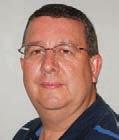
4 MAY 2014 | AMericAn LAundrY news www.AmericanLaundryNews.com Top Stories Appearing on AmericanLaundryNews.com for the 30 Days Ending April 15 (WE) = Web exclusive news • Gicewicz Assumes HLAC Presidency, Welcomes New... • TCATA Preps for Annual Gathering • La Quinta, Standard Textile Partner to Set Three World Records... • Fashion Seal, Gurtler Team Up to Offer Processing ‘Best Practices’ • HCSC Names Taylor Hospital’s Holobowicz Linen Coordinator of Year Columnists/Features • Examining What’s New in Textile Services Contracts • Cintas Clears Up Top Hazard Communications Misconceptions • Stepping Outside Comfort Zone All About Weighing Risk, Reward • Apex Linen Tech Investment Elevates Local Processing Standards our sister websites From AmericanDrycleaner.com:
Ozone Breathes New Life into Garments
•
The Magic in Your POS System (Conclusion) From AmericanCoinOp.com:
Maytag Fetes Top Distributors at 56th Annual Meeting
Parking: Make Your Case for the Space
•
COLUMNIST AT LARGE Eric L. Frederick, RLLD
ALN
ALN
Boehl
From The Director’s Chair
Bruce BeGGs
aDi DUraFiBer™ aDi ULtraFiBer™ aDi DUracLoth™ our newly enhanced ULtraFiBer™ “Foldover” design (patent pending) is first to market and best in class. these premium wet/dry combo mop pads efficiently deep-clean floors and baseboards at the same time. Premium hook & loop backing assures a ready to use product over and over again.
DUracLoth™ rounded-corner microfiber towels have a continuous-overlock edge design, for a no-fray, long-lasting neat appearance. the greatest benefits of a microfiber cleaning system come from using the proper cleaning techniques. ask us about the american Dawn microfiber total training Program! count on aDi... serious microfiber for serious cleaning.

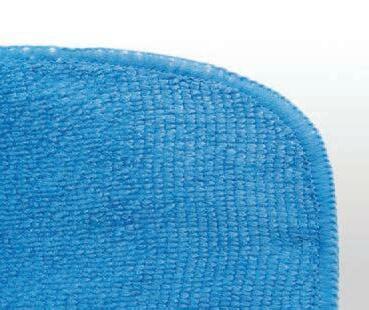

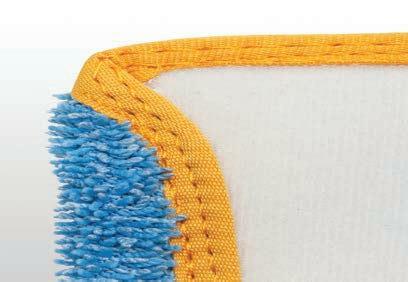
10 Distribution centers across north america microfiber@americandawn.com 800 821 2221 americandawn.com











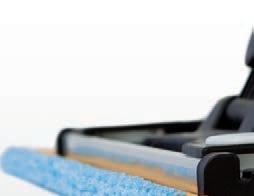
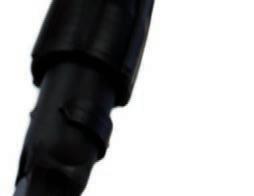




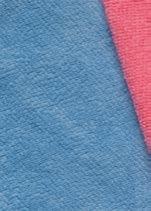

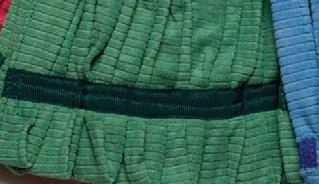
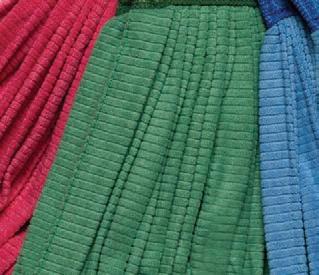













Tunnel washers: The answer to rising labor, utilities costs?
BY TheresA BoehL, ediTor
OSHKOSH, Wis. — For laundries looking to upgrade wash equipment, a continuous batch washing system (CBW®), also called a tunnel washer, might be an attractive option. But how is a tunnel system different from open-pocket washers, and how can a company’s operations benefit from this technology?
In Making Sense of the Tunnel, a recent webinar hosted by the Association for Linen Management (ALM), Seth Willer, national sales manager for Girbau Industrial, discussed the technology behind these systems and the advantages they can have over other systems in certain situations.
Willer also addressed the main driver for many companies looking to upgrade to tunnel washing systems: skyrocketing labor costs.
“I promise you the minimum wage will go up, and I promise you labor will get more expensive if you choose to operate your laundry in the U.S.,” he says.
Willer also points to the historical trend of replacing labor with technology.
“Technology is just increasing and increasing, and the laundry business is no different,” Willer comments. “We’ve aways had new technology emerging.”
WHAT IS A TUNNEL SYSTEM?
Willer says the textbook definition of a tunnel system is an automatic system with the capability to sequentially wash and dry batches of linen at a high production rate with great labor and energy efficiency.
Unlike a traditional front-load washer, which fills with water and drains with every wash phase, a tunnel washer’s phases occur as they move through various modules that are all connected to make one large system.
“To use a tunnel washer, you’ve got the same wash formula, but we’re doing it in a bigger configuration,” Willer says, explaining that a tunnel washer is like a series of open-pocket washers bolted together, side by side. This configuration allows loads to be continuously moving through the system.
“You could have 10 different phases of the wash cycle and you could have 10 different loads all washing at the same time, just in different phases of your wash formula.”
CLASSIFICATIONS
AND COMPONENTS
According to Willer, tunnel washers are typically classified by module capacity (in pounds of linen), by number of modules (usually ranging from around five to 20), by type of transfer (top or bottom), by existence of outer drum or by bath design or wash process. He listed the major components as a loading device (often a conveyor), the tunnel washer, an extraction device, an automatic shuttle and dryers.
There are two main types of tunnel wash-
ers on the market today: bottomtransfer and top-transfer tunnels. Bottom-transfer tunnels provide mechanical action through what Willer calls an “Archimedean-type screw,” which runs the length of the tunnel and provides back-and-forth agitation before rotating fully so the linen flows into the next module, where it will be exposed to another element in the wash cycle.
Bottom-transfer tunnels are ideal for high volumes of like items, Willer says, but they tend to have less mechanical action and some other limitations as well.
“Bottom-transfer tunnels don’t tend to be all that flexible when it comes to changing programs, and that’s where your inner and outer drum is key,” he explains. The outer drum, which acts as housing for the inner drum, is what allows for change in wash programs, and bottom-transfer systems typically only have outer drums around a few modules in the system.
“But if you have a large operation where all you’re washing are white towels, then a bottom-transfer will work quite well,” Willer says.
But for those who need more flexibility in their programs, a top-transfer tunnel might be the better way to go, he says. Besides having an outer drum that runs the length of the tunnel, allowing for inputs on any module, a top-transfer tunnel also features drums with a more significant rotation, picking up linen and dropping it repeatedly.
“An advantage of a top-transfer [tunnel] is you get good mechanical action,” Willer says. And that leads to the possibility of more flexible wash cycles, so wash formulas can be adjusted accordingly.
“In a lot of circumstances, if you can increase your mechanical action, you might be able to get by with washing in less water, or less chemical or detergent.”
But Willer is careful not to imply that a top-transfer tunnel is preferable for all operations.
“The top-transfer [tunnel] is becoming a popular model, but there’s no real definite answer because it’s all about what you’re washing and how you’re washing it, and what design is most advantageous to you,” he says.
FEATURES
Willer listed a number of features that are typically associated with tunnel washing systems: wash flow meters; auto-level drain valves; automatic chemical injection; automatic steam injection; computer controlled operation; on-board water reuse systems; and drain water heat recovery.
The method of water removal is another key element of a tunnel washer system. Willer says there are two main ways to extract water after washing: a press extractor or a centrifugal extractor. A press extractor uses a large hydraulic cylinder to literally squeeze the water out of the linen.
“It’s a lot like stepping on a sponge,” he says.
A centrifugal extractor, on the other hand, spins at 300 G-force, or 1,000 rpm, to extract the water.
Willer says the key difference between the two types of extractors is cycle time, with a press extractor getting the job done in 90 seconds or less, and a centrifugal extractor taking roughly 2-3 minutes. After extraction, a shuttle transfer conveyor transports the laundry to the dryers.

ADVANTAGES
“The two biggest advantages are labor and energy efficiency,” says Willer. He compares the production performance of a tunnel washer system to a split-pocket, side-load washer, which relies on manual loading of linen into the washer.
With a split-pocket washer, an operator can typically process anywhere from 250 to 400 pounds of laundry per hour, Willer says, but thanks to automation, a tunnel system has a pounds-per-operator-hour rate of 1,500 to 3,000.
“If you talk to operators that have switched from open-pocket to tunnel washing systems, the labor savings are astronomical,” Willer says, adding that the payroll costs for washrooms using a side-pocket washer can be as much as four times higher than those using a tunnel system.
There’s potential for significant water savings as well, Willer says, because of the way that a tunnel reuses water for various cycles.
“Your water comes into where your linen is going to be the cleanest. It comes in your final rinse,” Willer explains. Then the water flows “backwards” from later modules to earlier ones in the sequence.
With the help of storage tanks, water that is still fairly clean can be pumped to other parts of the system and used in the pre-wash or wash cycles.
A tunnel system will use anywhere from 400 to 1,200 pounds of fresh water per 1,000 pounds of linen, according to Willer, while

an open-pocket washer might require 1,800 to 3,000 gallons for the same amount.
“That’s a massive savings, especially if you’re in an area where water is scarce,” he says.
Operating with a tunnel system can also result in hot-water and detergent savings, and it also allows for thermo-recovery options, according to Willer.
IS A TUNNEL SYSTEM RIGHT FOR YOUR OPERATION?
With any serious investment comes serious considerations, and Willer urges those looking into acquiring a tunnel system to take several factors into account.
For one, how tall is the facility’s ceiling?
Tunnel systems need a minimum 12-foot ceiling clearance for installation, though 14 feet is preferable, he says. And a plan for redundancy is also important. What will happen if a tunnel washer goes down?
The goods that will go through the system should be considered carefully, since upping production could mean bottlenecking in the flatwork area. Also, load type should not be overlooked.
“If you have water from a load of red tablecloths, you’re not going to be able to use that bath to wash white sheets,” Willer says. “So if you have small specialty loads, a tunnel washer or CBW® might not be right for you.”
Finally, consider the capital it would take to purchase such a large, complex piece of equipment.
“It’s a big piece of machinery, and it’s not something that you can just go out and write a check for,” Willer says. “It’s a big investment.”
He advises that companies do plenty of research before making a purchase, and be sure to benchmark production and decide on an acceptable return period for the investment.
“Find a dependable vendor. Visit their references,” he says. “I cannot stress that enough.”
6 MAY 2014 | AMericAn LAundrY news www.AmericanLaundryNews.com
ALN
A 12-module Girbau Industrial TBS-50 continuous batch tunnel washer installed at Laundry Plus in Sarasota, Fla. (Photo: Girbau Industrial)
Willer
RATHER THAN DEBATE WHETHER OR NOT TIME IS MONEY, WE’LL JUST SAVE YOU BOTH.
On-premises laundry has to be done on time and on budget. And nobody saves more time and money than UniMac®. Revolutionary UniLinc™ controls monitor your laundry’s performance, allowing you to pinpoint areas where you can increase efficiency, and reduce labor, utility and maintenance costs. Unprecedented 400 G-Force extraction and a spray rinse with 200% quicker fill time put even more money back in your pocket by further reducing operating expenses and maximizing throughput. Industry-exclusive OPTidry ™ Over-dry Prevention Technology introduces cutting-edge sensors that automatically stop the tumbler once the ideal dryness level is reached, saving up to $2,000 in utilities, $6,000 in labor costs and decreasing the need for linen replacement with 31% less fiber loss. These groundbreaking innovations combine with unmatched durability and performance to provide commercial laundries of all sizes with the absolute lowest cost of ownership in the industry.
Incredibly-low monthly payments and a 4.50% FINANCE RATE now available on new UniMac washers and dryers. Limited-time offer.
Contact an authorized UniMac distributor today to run a laundry operating analysis and see how you can cut costs and save money. Visit UNIMAC.COM/TIMEANDMONEY or call 1-800-587-5458.
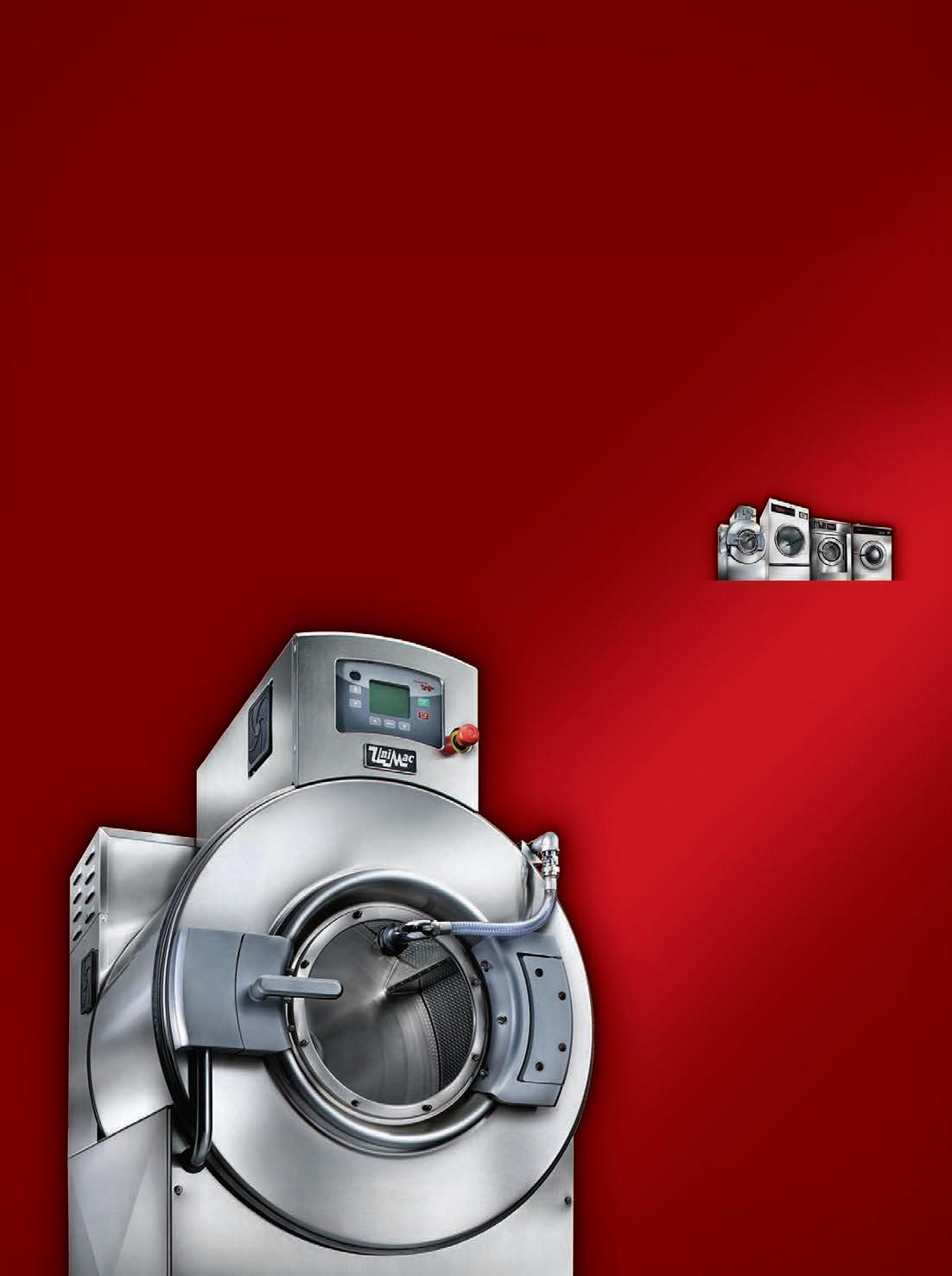
Tools f the Trade
Provider of OPL equipment adds new 200-pound
tumble dryer to product line
UniMac has introduced the UT200, a new 200pound tumble dryer with extra-large capacity and an efficient, high-performance heater box. Sealed cylinder rims and a concentrated airflow pattern ensure no heat escapes, helping to keep utility costs down and to maximize productivity, the company reports. The self-cleaning lint screen enables fast, efficient lint removal from the tumble dryer’s large storage area.
UniMac also offers its Combustion Auto Response Equipped (CARE) system as an added option for the UT200. CARE monitors for excessive cylinder temperatures and sprays water on the load should it register an abnormally high reading. A “system active” signal can also be sent to a property’s alarm system, laptop or another electronic device to notify the laundry or facility manager, according to the company.
Partnership
UniFirst has formed a partnership with Wrangler Workwear™ to provide new options for customers of its managed uniform and workwear programs.
Now available from UniFirst are Wrangler Workwear shirts, pants, shorts and work jackets, which are constructed from extra-durable canvas-weave fabric for added comfort and mobility, UniFirst reports. The apparel also features inseam and underarm gussets, backside pleats, and action elbows, designed for maximum range of motion, even when bending, squatting, lifting or climbing.
In addition to features for unimpeded performance, all
The UT200 is equipped with the UniLinc™ control system, which enables operators to monitor data and performance indicators, and pinpoint areas where there can be increased efficiency or decreased operating costs that are associated with labor, linen replacement, utilities and maintenance.
Additionally, OPTidry™ over-dry prevention technology is offered as an option. OPTidry precisely monitors the level of linen dryness, according to UniMac. Baffles are used as sensors and provide pinpoint moisture readings throughout the entire load. When the tumble dryer has achieved the pre-set level of dryness, it shuts off automatically. This eliminates inefficient energy use and reduces processing time, helping to lower both labor and utility costs.
www.unimac.com/info 800-587-5458

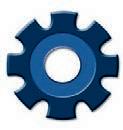
IPSO® has added a new 275pound washer-extractor, the IS275, to its softmount on-premises equipment line. It was built to maximize productivity and minimize costs while providing superior wash quality, the company says.
The IS275’s high-G-force extraction speed removes more moisture from linens to increase efficiency and reduce drying times by up to 40%, according to IPSO. The standard inverter drive also smoothly transitions from wash to spin cycle to reduce machine downtime. These features contribute to increased throughput and can reduce utility consumption by up to 25%, the company says.
The washer-extractor does not need to be secured to a concrete foundation, allowing for relocation
and installation in upper-level laundries, and can be installed for sameday operation.
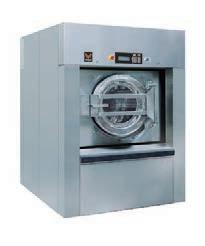
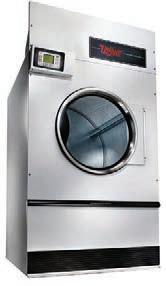


Other features include micro controls, an extra-strong door hinge, a large door opening and optional pneumatic tilting, IPSO says.
www.ipso.com
UniFirst and Wrangler Workwear apparel is designed to project a more professional business image through premium design features like double-needle stitching, banded collars with permanent stays and wider belt loops, UniFirst says.

Adam Soreff, director of marketing for UniFirst, says the new Wrangler offering “nicely complements our UniFirst branded lines of apparel because both address the importance of providing active workers with workwear they can look forward to wearing, which ultimately translates into being more productive on the job.”
www.unifirst.com/wrangler 800-455-7654
Vivid, high-def heat transfers apply to broad fabric range
A new product from Penn Emblem Co. addresses some of the challenges that traditional emblems, screen printing or direct embroidery can present for performance apparel decoration, according to the company.
PennTrans™ Transfers are digitally printed in vibrant color, and the versatile, highdefinition heat transfers apply to a broad range of fabrics, including temperature-sensitive performance textiles. They can be used to brand business casual wear and uniforms or to provide care/ content or personalized labels in a garment’s neckline or waistband. PennTrans digi-
tal heat transfers offer unlimited color capabilities and the ability to render exact details, and provide an alternative to direct embroidery or screen printing, Penn Emblem says. www.pennemblem.com 800-793-7366

Kaeser Compressors has introduced variablespeed-drive rotary screw compressors that deliver reliability, simple maintenance and sustainable energy savings, according to the company.

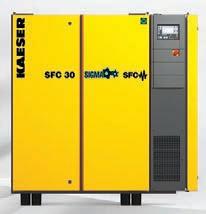

The SFC 30S and SFC 30 feature the latest in Siemens drive technology, and Kaeser says both models’ specific power has been improved by up to 6% through a combination of true direct-drive design, premium efficiency motors, lower internalpressure differential, and optimized airends.
The SFC 30S has a flow range of 37-171 cfm at 125 psig and is available with pressures up to 190 psig; the SFC 30 has a flow range of 47-202 cfm at 125 psig, with pressures up to 217 psig.
New features include an enhanced cooling design, eco-friendly filter element, integral moisture separator with drain, and an Electronic Thermal Management system, the company says.
The new compressors come standard with Sigma Control 2™, an intelligent controller with enhanced communications capabilities for seamless integration into plant control/monitoring systems.
Kaeser also offers the SFC 30S and SFC 30 with an integrated dryer for premium compressed-air quality.
www.us.kaeser.com 877-586-2691
The Dickies® Occupational Wear division has added a healthcare collection for the textile rental market.
The new collection was developed specifically for the industrial laundry market, with industrial-strength fabric for extended garment life, the company says.
Features include adjustable waists on scrubs, task-driven pocket designs, and accents on scrubs, coats and jackets.

Customers can
choose from v-necks, classic lab coats, mock wrap tops and snapfront jackets, among others.
Also new from the Occupational Wear division are head-to-toe uniform products for the hospitality and foodservice industries, the company reports.
Strategic Partners is collaborating with Dickies to design, source and manufacture the new collection.
www.dickies.com 800-336-7202
8 MAY 2014 | AMericAn LAundrY news www.AmericanLaundryNews.com
New washer-extractor uses high-G-force extraction speed to remove moisture
brings extra-durable canvas-weave fabric to uniform/workwear programs
Variable-speed rotary screw compressors designed to offer sustainable energy savings
collection
industrial-strength fabric
Healthcare
developed with
equipment technology as some recent drivers of wash-formula change.
Developing chemical wash formulas that increase longevity of merchandise and utilize lower alkali and bleach in wash cycles has been part of the focus at Norchem Corp., according to Kevin Minissian, vice president at the company.
For Steve Kovacs, R&D manager for P&G Professional, a number of changes in the last few decades stand out as notable: the phasing out of phosphates; the emergence and dominance of liquid form; increased use of enzymes and polymers to enhance cleaning; and a move from alkaline wash conditions to near-neutral, to name a few.
WHAT ELSE MATTERS?
Making the most out of chemical formulas means paying close attention to what is being cleaned and how.
Soil-sort accuracy, load-size optimization, the linen’s fabric composition, and finishing capacity (folders, ironers, post-wash operations) are some key factors outside of the basic four that can play a role, according to Lang.
Kovacs adds other chemical considerations to the list, warning operators to think about, for example, whether using products from multiple manufacturers will result in harsh alkaline wash conditions that lessen linen life.
“One thing that people may not consider is quality,” says Tinker. “There are … some laundries out there that have very, very high quality standards. And that can definitely affect your wash formula, [as] opposed to others who might have standard quality requirements.”
Regarding textiles, industry professionals find that they can present challenges for choosing wash formulas, since a move away from traditional cotton materials often means a new approach to getting textiles clean.
Synthetic materials are rising in popularity, but they’re more “oilloving” and “challenging to get clean,” according to Lang.
Kovacs adds that poorly woven fabrics often end up costing businesses more in the long run, and suggests that working with a reputable linen supplier is just as important as working with a good chemical supplier.
Staff members, too, can contribute to the effectiveness of a wash formula, whether they realize it or not.
“Sometimes employees select the wrong classification,” Tinker says. “They may not be paying attention … or they may underload or overload the washer, which
can create a problem.”
There is also the issue of employees choosing shorter cycles, thinking it will lessen their workload, according to Kovacs. And neglecting to do preventive maintenance on equipment can further affect the quality and cost, says Lang.
CLASSIFICATIONS, EQUIPMENT, FACILITIES
Opinions were mixed from those polled on whether it is best to have a few, broad-ranging chemical wash formulas or a for-

mula for each specific classification.
“In general, simplicity will also drive good results,” advises Kovacs, saying that having too many choices is not cost-effective considering the additional inventory costs, and that having too many will increase the chances of formula mix-up. He suggests having a “detergent, bleach and softener.” But Tinker says that having a wash formula for every classification will lead to increased efficiency, at least for a washer-extractor type of laundry.
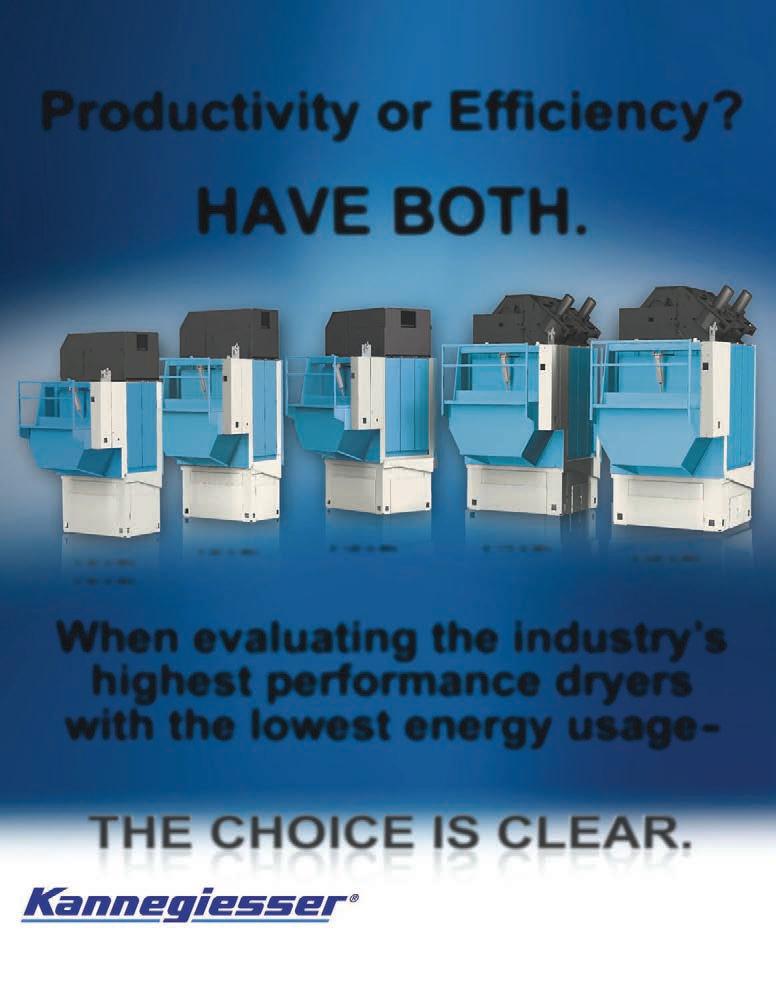
He adds that in “a tunnel washer operation, it is difficult to modify wash formulas significantly, as these systems are best operated with a high-volume throughput of similar classifications to maximize efficiency.”
Lang calls choosing formulas for various classifications a “balancing act.” He points to each operator’s core competencies—what markets they serve and what they do best— as the most appropriate guide to questions of more vs. fewer formulas.
Formula development should take into account the specific con-







ditions and needs of each plant, Tinker says, such as in the case of a facility that is focused on cutting down processing time, or a facility that deals with high wastewater costs.
STAYING HEALTHY, GREEN AND CLEAN
Chemicals can have an impact on the environment as well as the health of the people who come into contact with them. The laundry industry continues to be affected by new requirements and
www.AmericanLaundryNews.com AMERICAN LAUNDRY NEWS | MAY 2014 9
ALN_Jr Page.indd 1 3/27/14 2:35 PM Continued from Page 1
See WASH on Page 17
Wash
PAnEL Of ExPErts
Solving language and communication issues


include a culturally diverse group whose origins include all parts of the world. At present, four different dialects from one continent plus one other foreign language are spoken within my department.
Here’s my strategic “Top Five” list of initiatives for success:
Our industry, depending on the geographic location, has included a diverse cultural staffing model for years, but English as the second language has never been more prevalent than it is today. It’s a challenge just like any other we face in the work environment.
An executed plan must prevail!
With communication always being the key to any successful business and/or relationship, the necessity of a leadership and financial commitment must be recognized first. In my experience, this commitment produces plenty of ROI for an organization and department. With that said, I would like to focus on the “resources available.”

To start with, we need a strategic plan for meeting and satisfying the growing communication challenges we encounter. Our modern-day workforce can easily
1. Utilize an internal or contracted interpreting service. This helps avoid having an HR issue when department staff members act as interpreters for an employee training session or correctiveaction matter.

2. As much as possible, staff assignment should reflect a combination of “best fit” with best communication skills. In a busy work environment, speaking with our customers and being able to give them the reassurance through communicating that we’re taking care of them is critical.
3. Manager, supervisor, lead— whatever the titles of a department leadership team, ensure there is a consistent daily plan in place for providing a safe and productive work environment.
4. Consistency in on-boarding, training/development and continued competency review. It doesn’t matter what the language is, if this is missing, there’s no business being in business. Is there a documented, signed-off hiring and ongoing employee development protocol?
5. Recognize our No. 1 asset of the business: our employees! Giving reassurance to recently immigrated staff members can make all the difference in the world to them and their families as they adjust to their new culture and world.
Of course, there can be more to consider, such as an HR department requiring a certain level of English-language competency, the interview process requiring the applicant to speak enough English without having to use an interpreter, and the possibility of providing a mandatory ESL class for employment.
With regard to equipment, the impact starts and ends with employee safety, and brings into play all of the aspects of this topic in between.
Looking at OSHA code 1910.145, paragraph (c), it’s clear that employees must be trained on and made to understand the hazards referred to on safety signs of machines, regardless of what language they speak and understand. This OSHA code now gets matched with ANSI code Z535.4, which explains the proper formatting of safety signs on equipment to include key signal/international words and pictures.
So what operators are left with is that employees must be trained on and understand the safe operation of the equipment in the facility. They must also completely understand the safety signage and safety components, and the facility should keep accurate, updated records to show this training and understanding taking place on a regular basis, at the time of hire and at least annually thereafter.
Another issue operators face is elimination of the “grandfather clause” referring to existing equipment in a facility. For existing equipment and equipment being sold in the pre-owned market, the codes clearly state that if equipment is moved from its original installation location, the equipment must be brought up to all current safety components and signage. Secondly, if a piece of equipment is rebuilt or refurbished by the OEM (original equipment manufacturer) or a non-OEM rebuilder, the safety components and signage must be brought up to current code.
With these obligations now in place, when looking at the purchase of a pre-owned or rebuilt piece of equipment from a nonOEM rebuilder, due diligence should be taken to ensure the equipment meets the ANSI codes. For existing equipment in a plant, if the OEM is still supporting a particular piece of equipment, they can be contacted to see if safety labels are available for the equipment.
Once the ANSI codes are met, it is now time to tackle the OSHA codes regarding employee training. The OEM may be able to provide assistance in this arena as well. If they are ISO-certified, they probably have formal and documented training protocol established and can be retained to provide such. At the plant level, seeking out bilingual employees to have them take part in training classes can work well and help reduce the cost of training employees.
From there, if bilingual support is needed for training activities, local colleges and universities may be able to provide a lower-cost service than dealing with a private party. What is important with all training activity is that the scope of training is clearly documented and retained, that the employees’ specific signatures are retained to show that they received and understood the training, and that the training is conducted on a regular basis.
10 MAY 2014 | AMEricAn LAundrY nEWs www.AmericanLaundryNews.com
English is tough to learn and understand. However, in my experience, the spoken English language has not been an issue.
“English is a second language for some of our workers. In what ways could this language difference impact our laundry operation? What resources are available to help me tackle language or communications problems within my staff?”
Long-term care Laundry
Brian Barfoot
Equipment Manufacturing Gary Ostrum G.A. Braun Syracuse, N.Y. (Photo: ©iStockphoto/CurvaBezier) • • • • • • • • • •
Aberdeen Village/ Aramark Olathe, Kan.
I have experienced a language barrier of another sort—concerning the deaf and mute—where an individual was unable to hear what I was saying or to communicate by speaking. This posed problems in certain areas, and trying to convey a message proved to be challenging at times.
What can someone do in this situation? I learned sign language through an interpreter over the course of six months to better communicate with my staff.


We also spoke through messages on a computer system using two connected laptop computers to type and read messages in real time; this service was provided as a courtesy by the West Virginia Division of Rehabilitation Services. It was effective if we were having a meeting and could not have an interpreter available at that time.
Employees were also given training manuals to read over so they could get the basic functions of the position. We then gave them hands-on training so they could acclimate quickly.
For our efforts, our company was honored as “Employer of The Year” in 2012 by The West Virginia Department of Human Resources, Rehabilitation Services Division. It was a great honor and privilege to be recognized.
English cannot always be spoken, but there are other ways to communicate. Managers and co-workers have to have an open mind when dealing with language barriers and adapt accordingly.
things, manufacturers like Laundrylux have recognized that there are many people who speak multiple languages. Equipment that can display wash instructions in multiple languages can help to prevent potential problems in the laundry room.







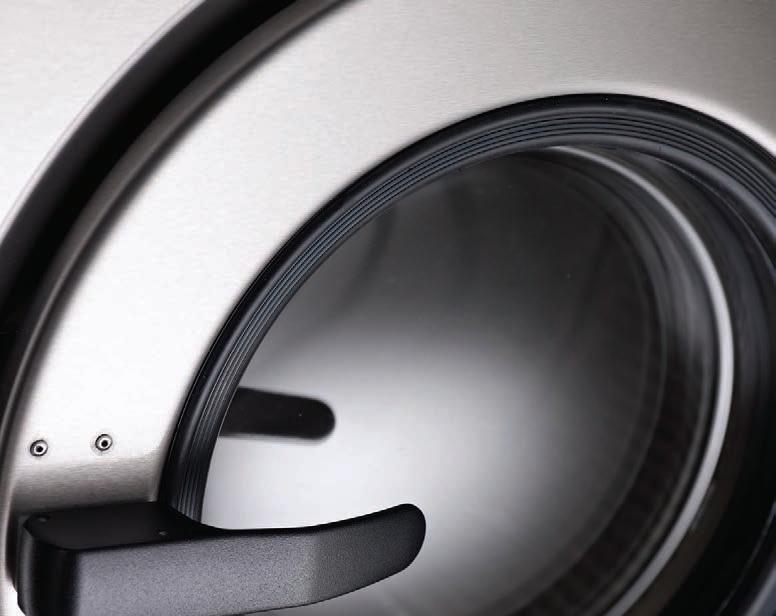
Laundry rooms can display rules and regulations in multiple languages as well. This allows all members of the laundry staff to have similar understanding of the procedures in their workplace.
Breaking down any language barriers is key to operating a safe and efficient laundry.

The laundry industry has become a much more diverse setting than it was 20 years ago. Plant locations and changing demographics in many regions of the country can attest to this fact. This has required us to make
changes in how we communicate not just basic information, but the entire gamut of information we use every day, in order to continue to be successful.
This starts with a newly hired employee and the training process. Over the years we have gleaned information, training materials, safety data, forms, contracts, etc., in multiple languages, depending on the workforce in each location. For any company, the key to success is conveying accurate and timely information to its employees.


Training videos for a multitude


of safety topics are critical in any healthcare laundry. Our training encompasses bloodborne pathogens and universal precautions, lockout/tagout, evacuation plans, MSDS, all company policies and much, much more. This all happens before an employee ever sets foot on the production floor.
In this information age, you can get these resources anywhere online; there are multiple sources. While I am not recommending any one company, we use resources from Brady, Coastal








communication among workers is key to running a successful laundry. If multiple languages are being spoken in a laundry room, it is important that the entire team understands the processes for running the laundry, regardless of the language being spoken.
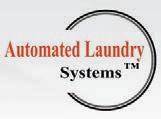
Management needs to be sure that its team understands what is being expected of them as far as production, and that any language barriers are addressed before work begins. If there is a clear understanding of the tasks at hand, then any potential issues that might arise due to a “language misunderstanding” will be mitigated.
On the equipment side of







www.AmericanLaundryNews.com AmericAn LAundry news | m Ay 2014 11
See EXPERTS on Page 12 At Automated Laundry Systems, we deliver innovative solutions and expert resources to on-premises laundries throughout California. We’re focused on bringing you the most durable equipment that is built to perform—load after load. That’s why we partner with IPSO.® Backed by more than 40 years of European ingenuity, the industrial design and performance of IPSO make managing your laundry easier while improving efficiency. For a limited time, upgrade your laundry for as little as $99/month. Contact Automated Laundry Systems to get started today. INDUSTRIAL
automated-laundry.com 428 N. Moss St., Burbank, CA 91502 • (888) 875-9556 HEAVY-DUTY MACHINES. INDUSTRIAL-STRENGTH PARTNERSHIP. ALN_Jr Page.indd 1 4/8/14 4:01 PM equipment/ supply distribution Justin Oriel Garment Machinery Co. Needham, Mass.
Hotel/motel/ resort Laundry James Brewster, RLLD The Resort at Glade Springs Daniels, W.Va.
BY DESIGN
Healthcare Laundry Michael Kirsch, CLLM
HCSC
Laundry Allentown, Pa.
(now DuPont) and Grainger. We do annual retraining for some of the OSHA and HLAC criteria as well, and this is done through an online video training company called Mastery Technologies.
When the employee hits the production floor, there is another phase of training that is extremely hands-on. It is a basic “show and tell.” Safety of the employee and their co-workers is critical. There is signage in multiple languages everywhere. These are at entrance/ exit points, fire extinguishers, machine guards and pinch points, locations of hazardous materials or conditions, and the list goes on.
The most important button on a machine is the emergency-stop switch. Each new employee needs to have this basic information prior to feeding the first piece. All of these things are “day one.”
Some plants have a “buddy system” that partners a seasoned employee with a new hire. This is usually the person next to the individual in any department who speaks the same language. The experienced person is shadowed for the first week or two to help the newcomer learn the ropes.
Additionally, we have found it helpful (though not required) to have bilingual supervision or lead personnel. Many times, written instructions and direction are in specific terms. This has been helpful, because there are many dialects in any language.
Plants that don’t have bilingual supervision should have at least one or two designated translators per shift. We have also done classroom work and offered tuition reimbursement for supervisors willing to learn another language. Basic words and phrases spoken in another language go a long way toward maintaining a good, safe work atmosphere. This helps to solidify the message regarding whatever the job requirement may be.
All production reporting forms have been converted to multilanguage forms for the ease of the employee to record, as well as the supervisor to report, daily results. Most of the time we are dealing with numbers, which is a much more universal language.
to communicate among staff, regardless of what language is involved. It could be lip reading, sign language, Spanish, or one of the Asian languages. Most colleges have a department that can help with interpretation of documents, and the Internet can help as well. Larger cities have translators or interpreters.
Of course, the best way to communicate with employees is to speak their language, and an alternative to that is to have a person in a responsible position who will translate for you. Simple pictures posted in strategic places can be helpful as well.
Language is one issue, but cultural differences can be a barrier in relaying information. For instance, we as managers may simply see someone as a “woman” or an “older worker,” but those from other cultures may see a “mother” or “elder” and naturally defer to that person’s station in life.
Then there are those who do not feel comfortable being supervised by women. These are not necessarily negative qualities, but the outcome can be negative if the manager doesn’t recognize the situation.
Language barriers can make it difficult to project expectations without offending or misleading the employee. My wife and I speak the same language, but sometimes one of us is offended when the other assumes the request was not understood and continues to explain what needs to be done.
I feel strongly about making all instructions simple to require as little thought as possible. The tasks that are simple have a greater chance for success than the ones that have multiple layers and options. Remember, we hired these workers and we are paying for their time. We owe it to everyone to help them be as successful as possible.
approach work every day and expect our employees and workforce to give us 100% effort.
In order to achieve this goal consistently, it is important that we communicate well with each other.
If our employees do not understand what is expected on a consistent basis, shame on us for not communicating the message by any means possible. Not conveying our message clearly will have a negative impact on the quality of the product going out the door to our customers.
Poor communication leads to poor productivity, inferior quality and, unfortunately, at times an unsafe work environment that can lead to serious injuries and, in some cases, some hefty workers’ compensation claims.
Our workforce today is more non-English-speaking than ever, which can create some serious challenges to all. It is important that we take the necessary steps to ensure our message is communicated properly to our employees. Companies today are taking multiple steps and reaching out to various resources to implement special practices to ensure good communication is rampant in their place of work. Some may include:
• Hiring of tutors to teach English to non-Englishspeaking staff during breaks or after hours.
• Hiring tutors to work with management to teach them the foreign language needed to communicate effectively with employees.
• Working with Human Resources to place proper signage in dual languages and with pictures to get the message across to employees.
• Making sure the lead person or supervisor in charge is fluent enough in the secondary language to communicate to employees what needs to be done, such as job expectations and tasks at hand.
This is a tough subject, and although the question is posed in a politically correct manner, it is ignoring the elephant in the room. It’s the new face of America! The language is Hispanic, the people are Hispanic. Some are in the country illegally, many are not. The issue as presented is one of communications. My personal feelings regarding the immigration laws are irrelevant, my opinions for my clients are based on getting the job done, nothing more!
Personally, I think Hispanics make up a welcome and needed workforce. They’re exceptionally hard-working and industrious. They will do what the entrylevel English-speaking jobseekers will not do. Their work ethic is reminiscent of that in the stories told by the old Irish, Polish and Italians who came to this country in the early 1900s for a better life. Let’s face it—if there wasn’t a need, they wouldn’t have come here.
The Spanish-speaking workforce is estimated to be more than 75% of the production employees in today’s mid-sized and mega plants located in populated areas. That being said, one of the methods that has been proven to successfully assimilate this powerful workforce into the system is to let them have some control.
may be in question. It may surprise you to actually see how easy it is to comply with the law.
w
henever there is poor communication, there will be adverse or negative consequences. There must be a way

Today, in order to run a successful and profitable business, good communication skills are a must. These skills are expressed either verbally, by signage or by colors. More and more members of our laundry workforce today either do not speak English, or consider English their second language and means of communication. This, more often than not, can make it challenging for management to communicate to the workforce concerning quality, productivity and, most importantly, employee safety.
As owner/operators and/ or managers/supervisors, we
Garment manufacturers and machinery suppliers are also helping overcome language barriers. Machinery suppliers are manufacturing equipment with proper signage to display the do’s and don’ts of proper operating procedures, while garment manufacturers are offering to produce color-coded apparel and uniforms that will help employees identify specific sizes and styles. This color coding can be done several ways: neck labels; neck tape or binding; twill tape; or the fabric itself.
By taking the time to teach and work with our workforce and our suppliers, together we can overcome the communication challenges and make the language barriers go away in the wash.
The most successful plants have a bilingual supervisor or plant manager. These trusted bilingual leaders will take control of the staff and, under the direction of the owner or general manager, direct the people. These leaders, when instructed properly, will organize their people, put the right people in the right jobs and protect you from the usual problems seen on the production floor.
They will not only direct, discipline, fire, replace and do anything that is required of them, they will get the job done. These people are self-motivated and self-disciplined. This approach is extremely effective and successful in plants just like yours across the country. The Hispanic people, as a whole, take great pride in their work and want to get the job done right. They will work 12 hours a day and longer if needed. They expect others to work as hard as they do and will take each other to task if they don’t produce.
Upper management must be fully aware of laws regarding the employment of any people who



T
his is a timely, yet difficult topic to express an opinion about. I think it not only affects us in our work environments, it affects us in many other situations.
I called my bank several weeks ago and it took me forever to understand what the “customer service” person was saying to me. She, likewise, had a difficult time understanding my inability to get my thoughts across to her.
As I was mumbling to myself, I remembered when I was in Germany trying to tell the lady in the “Apotheke” (they don’t use “drugstore”) that I needed something similar to aspirin, and the shoe was on the other foot.
I am reminded of one of my VA laundry manager friends who told me about having several people who worked for him who all spoke different languages. He had three language groups to deal with, and two of those three did not speak a common language. He worked hard at learning how to talk to each of them in their native tongue. Then he helped them learn some work-related terminology so they could do their job.
I sat one afternoon in the lunchroom with all of them and listened to the chatter between half of the laundry. Everyone was speaking his/her own language but at the same time understanding what the others were saying.
After lunch, I told him I didn’t understand a word that was spoken, but I did pick up on when to laugh along with the rest of the crew. He chuckled and told me they were laughing at me. Why? Because my head was turning from side to side as I tried to be a part of the discussion and they were telling each other I didn’t know what was going on.
I admire my laundry manager friend for working so hard to learn enough of the other three languages to be able to communicate with the people who work for him. I know I am wrong in not doing the same. I still speak only English. However, I am working on learning a second language.
So if anyone wants to speak a little German to me, please do, but I only have a few words down pat. Wo ist der Getränkeautomaten? Wo ist die Toilette? That’s the best I can do, but I am working on it!
12 MAY 2014 | AMericAn LAundrY news www.AmericanLaundryNews.com
ALN
continued from Page 11 uniforms/ workwear Manufacturing Scott Delin Fashion Seal Healthcare Seminole, Fla. commercial Laundry
Warren Linen King Conway, Ark.
experts
Richard
consulting services
Sam Garofalo
Technical Consulting Associates Charlotte, N.C.
for More sTories feATuring our PAneL of exPerTs, visiT www.AMericAnLAundrYnews.coM!
Textiles Hal Herweck Phoenix Textile Corp. O’Fallon, Mo.
TRSA Safety Summit calls for better industrywide practices





ALEXANDRIA, Va. — An upcoming Textile Rental Services Association (TRSA) event seeks to pinpoint the issues that prevent laundry managers from achieving the best possible safety performance levels.

TRSA will host its third annual Safety Summit on June 18-19 at the Omni Nashville (Tenn.) Hotel. Its Safety Committee has planned discussions that focus on creating a “safety culture” in the industry, aiming for reduced incidents and injuries through “novel approaches.” The event is presented in cooperation with the CSCNetwork (The National Alliance of Independent Launderers).

According to TRSA, too often managers work primarily toward compliance and requirements, rather than employing new strategies and techniques for ensuring safe workplaces. The Summit will help identify obstacles and develop consensus proposals for dealing with them, the association says.
Safety and health professionals from inside and outside the industry will present practical information designed to reduce workplace illnesses and injuries. Members will share concepts that can improve safety by 20-40% compared with the industry as a whole, says TRSA, and attendees will work together to develop practices to “increase protection, productivity and profitability.”
The Summit is designed for owner-operators; corporate executives; general, plant, production, engineering and safety managers; and others responsible for safety, health and human resources, according to the association.


TRSA is also offering nine credit hours toward recertification to individuals who have achieved TRSA’s Certified Professional Laundry Manager credential.

The Summit opens with a welcome reception beginning at 4:30 p.m. Wednesday, June 18 (registration will open at 3).
Activities on Thursday, June 19, will begin at 7 a.m. with a breakfast and welcome by Joseph Ricci, TRSA, and Jamey Cashman, CSCNetwork, along with an update by Rick Gerlach, chairman, TRSA Safety Committee.
Sessions will run from 7:45 a.m. to 5 p.m. and include several “best practices” breakout sessions:
• 7:45-8:30 a.m. — Fostering Communication, Ensuring Engagement is the focus of a presentation by John Eapen, VP, Environmental, Health and Safety, American & Efird (A&E), in the day’s first general session.
• 8:30-9:45 a.m. — Speaker Don Bock, owner/operator, Seabright Safety Solutions, will discuss Behavioral Safety
• 10-11:15 a.m. — Concurrent breakout sessions begin with a panel on Using Telematics to Monitor Driver Safety Scheduled panelists are Eric Davis, AmeriPride; Dan French, G&K Services; and Rob Potack, Unitex. Rich Gerlach, Cintas, will be mod-
erator. Dealing with the Aging and Obese Workforce will be presented by Lance Fredericks, Zurich Services Corp., and moderated by Terry Drake, G&K Services.
ALN_Jr Page 5/2/12 9:58 AM Page 1
• 11:30 a.m.-12:45 p.m. — In the second set of breakout sessions, Jim Flanagan, assistant administrator, Tennessee OSHA, will present Securing the Coveted VPP, while a representative from Travelers



















Insurance will present How Situational Awareness Improves Safety, moderated by Charlie Edelman, Unitex.
• 1:30-2:30 p.m. — Afternoon general sessions will begin with Safety in the Commercial Laundry Industry by Edwin Foulke, Fisher & Phillips.
• 2:45-3:45 p.m. — Bruce Thomas, manager, Health and Safety, UPS East Region, will present Fleet Safety Training:
How UPS Trains its Drivers.
• 3:45-5 p.m. — Activities close with a panel discussion on Textile Services Executive Management Perspectives. Panelists are to include Jim Buik, Roscoe Co.; Jim Butz, Clothes Clinic; Ed Heilman, Ace Imagewear; and David Struminger, Mohenis Services. To learn more about the event, or to register, visit www.trsa.org/ safetysummit. ALN
Notice Anything?














InkGo® Is Now Odor Free!
InkGo has been reformulated to remove its odor… and to improve its performance.





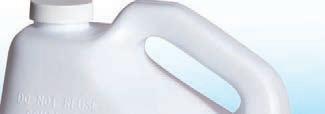

It's still the environmentally friendly,* safe way to remove ink stains from all types of fabric. It’s still great at removing autoclave tape and adhesives. And since it’s odor-free, it’s more pleasant to work with.









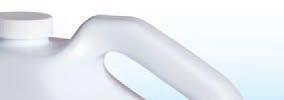


Now that's worth noticing!
*InkGo is Biodegradable and is California Prop-65 and California VOC Compliant. To Learn More, Visit ALWilson.com or call 800-526-1188

www.AmericanLaundryNews.com AmericAn LAundry news | m Ay 2014 13
Myers joins B&C Technologies sales team
PANAMA CITY, Fla. — B&C Technologies has hired Sonny Myers as sales manager to further expand its local client base, the company reports.
Myers brings more than 30 years of industry experience through owning and operating two successful laundry/warewash chemical and equipment companies, B&C says. His vast experience will allow him to assist clients when making purchasing decisions, the company adds.

B&C says Myers is well known as a community leader through his volunteer work with charitable events and non-profit organizations.

“We are excited about adding Sonny to our sales team,” says Al Adcock, B&C vice president of sales and marketing. “His wealth of experience will allow us to expand our efforts and better cater to our local market.”
“It’s great to be part of the team here at B&C Technologies; their professionalism is unsurpassed in the laundry equipment market,” Myers says. “I’m proud to a representative of B&C Technologies, knowing our customers will have the best!”
G.A. Braun hires Tippett as project field supervisor
SYRACUSE, N.Y. — G.A. Braun reports that it has hired Robbie Tippett as project field supervisor on its Inside Sales & Project Management Team. He will be responsible for coordination activities within Braun’s
Track Career
organization between engineering, manufacturing, logistics, sales and service.

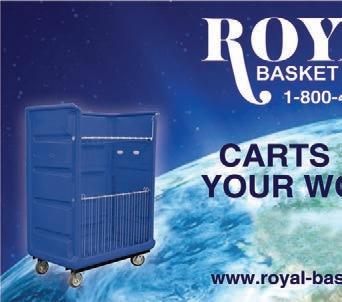
He is also responsible for interfacing directly with architects, electrical and mechanical contractors, installation/rigging contractors, utility systems engineers and Braun’s customers throughout the lifecycle of a project.
Over the past 35 years, Tippett has served in a variety of operations, sales and service roles within the commercial laundry industry, Braun says.
Most recently, he was a managing partner with T&C Rigging and had responsibility for the execution of countless equipment installation projects throughout the United States.
Previously, Tippett was with the WJ Tippett Co. in Maryland for more than 27 years in the capacity of equipment sales, installation and service.

“We are extremely excited to have Robbie joining Team Braun. I am confident that Robbie will further strengthen … our ability to develop solutions for our dynamic customer base and support our strategic growth initiatives,” says Cliff Quick, Braun’s director of inside sales and project management. “Robbie possesses a wealth of knowledge, not only with Braun equipment, but with the laundry industry that we support.”
Berge returns to American Laundry Systems staff



HAVERHILL, Mass. — American Laundry Systems, a division of E&O Mechanical, has welcomed Charles Berge back to its staff as vice president of sales.
The 34-year industry veteran
originally joined the company in 2004, working with President and CEO Gerard O’Neill to gain experience in laundry design and facility renovations in the healthcare, industrial, food and beverage, hospitality and cruise line laundry operations.
Berge will now oversee ALS’ consulting, engineering and installation services throughout North America.
He got his start in the industry in 1980, spending 16 years with Aramark Uniform Services, holding several positions ranging from route representative to general manager. He has also worked for Brim Laundry Machinery, Dallas, learning the capital equipment side of the industry while covering a Midwest territory of 10 states.
Most recently, Berge spent two years with Venus Group, covering the U.S. Midwest and Canada for the textile company.
Berge has been an instructor at TRSA’s Production Management Institute and Maintenance Management Institute.

Delin promoted to VP of sales at Fashion Seal
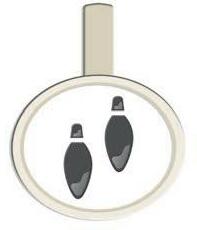
SEMINOLE, Fla. — Fashion Seal Healthcare, a brand of Superior Uniform Group, recently promoted Scott Delin to vice president of sales, the company reports.
Delin will lead the development of programs and training for laundries and healthcare facilities, according to the company, offer-
ing customers “technologyappropriate, cost-effective and efficient solutions to promote business growth.”
Delin has been with Fashion Seal Healthcare since 2004, having recently held the position of senior national healthcare market executive. With 30 years of experience as a laundry operator, Delin has extensive background in apparel production and the textile industry, the company says.
He serves as a board member for the American Reusable Textile Association (ARTA) and for the Textile Rental Services Association (TRSA), where he is also a member of its Healthcare Committee.
Delin is also a member of the Healthcare Laundry Accreditation Council’s (HLAC) advisory committee, and the American College of Healthcare Executives.
“Scott Delin’s background of garment manufacturing and commercial laundry operations gives him a unique perspective in the healthcare laundry marketplace,” says Alan Schwartz, president of Superior Uniform Group, parent company of Fashion Seal Healthcare.
“His experience allows him to add great value in a consultative role to his customers that exceeds their expectations in a changing healthcare landscape.”
Delin has a bachelor of science degree in textile and apparel management from Philadelphia University.
DeJong as senior product manager, the company reports.
Prior to joining Maytag, Smith worked in a variety of roles in sales, brand, merchandising and product development, most recently at Whirlpool Corp.
In her new position, she will lead the Maytag Commercial Laundry brand strategy, development and execution of public relations and key influencer strategies, the company says. Smith has a bachelor’s degree from Western Michigan University.
DeJong joins Maytag Commercial Laundry after 12 years in residential brand marketing, product category management, professional sales and sales enablement at Whirlpool, most recently serving as the company’s brand manager. He has also served as a product category manager for top-load washers.
In his new role, DeJong will be in charge of all Maytag Commercial Laundry newproduct development. He holds a bachelor’s degree from Calvin College.
ST. JOSEPH, Mich. — Maytag
“Dawn and Eric are proven leaders who will help us grow our business through their strategic product and marketing efforts,” says Bob English, general manager for Maytag Commercial Laundry. “With extensive industry-related experience, we are better poised to support our customers and our robust commercial laundry product portfolio.”
Maytag Commercial Laundry welcomes Smith, DeJong
Commercial Laundry recently welcomed Dawn Marie Smith as marketing manager and Eric
ALN
DeJong
Smith
Tippett
Myers
Delin
ALN_Tab_1-4_H.indd 1 7/16/13 3:58 PM 14 MAY 2014 | AMERICAN LAUNDRY NEWS www.AmericanLaundryNews.com
Berge
McGuire VA Medical Center revamps textile care plant


RICHMOND, Va. — The Hunter Holmes McGuire VA Medical Center here has overhauled its textile care processing facility, which cleans millions of pounds of laundry for the medical center and nearby hospitals and military bases.
The plant’s refurbishing makes it the first steamless laundry in any federal facility, according to Western State Design, which partnered with R.W. Martin & Sons to complete the project. Cost of the renovation exceeded $8 million.

Major changes and additions were unveiled during a March 13 grand opening. Attendees toured the renovated facility after a ribbon-cutting ceremony led by Albert Boyd, textile care manager of the McGuire VA Medical Center.
“We went from the stone age to the 21st century,” says Bruce Jensen, a member of the VA Quality Assurance team.
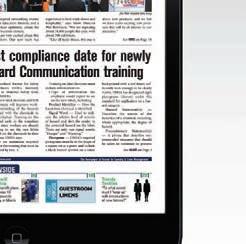

The new facility features automated equipment to replace manual processes, and ergonomic equipment designed to reduce the impact of repetitive motion for employees, Western State Design says. The new equipment is designed to save time, energy and water. It will be used to process laundry and uniforms for the McGuire VA and will also process soiled linen from Joint Base Langley–Eustis, Camp Peary, Fayetteville North Carolina Military Bases, Fort Eustis, Fort Lee Military Base and Hampton VA Medical Center.
“After touring the plant today, it is obvious that this accomplishment by Western State Design and R.W. Martin is in fact an engineering marvel of its own,” says Ken Tyler, former long-time director of Textile Care Operations at the Department of Veterans Affairs.
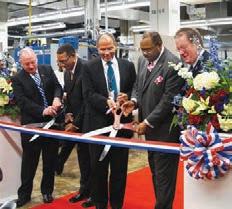
Newly installed equipment includes an E-Tech soil overhead semi-automatic monorail conveyor system with five storage monorails; a Milnor six-module, 150-pound-capacity continuous batch washer with PulseFlow technology; a Milnor single-stage, 56-bar press/extractor; and four 300-pound Milnor dryers.
Additionally, the plant renovation includes a 600-pound Consolidated natural gas dryer; two Century two-roll, 52-inchdiameter self-contained thermal ironers from Chicago Dryer Co.; and a Colmac Industries steamless self-contained garment tunnel finisher, among other new pieces of equipment.
The facility will also make use of three Milnor 100-pound washerextractors and three 120-pound
Cissell dryers, which will accommodate smaller loads of uniforms, rewash and specialty linen. All of the laundry equipment installed was made in the United States, according to Western State Design.
Newly revamped features of the building are the interior mechanical plumbing and electrical systems, an air handling system, and the clean- and soiled-linen production areas, which are now separated by a glass barrier.
Western State Design furnished the equipment for the renovation, and R.W. Martin & Sons completed the installation. The original laundry installation occurred in 1977, and the conventional equipment replaced in this latest renovation was installed in 1991.
“It’s just amazing to see how far the systems have advanced,” says Anthony Tura, another member of the VA Quality Assurance team.
Man
Officials cut the ceremonial ribbon at the McGuire VA Medical Center textile care processing facility: (from left) John A. Brandecker, director, Richmond VAMC; Albert H. Boyd, textile care manager, Richmond VAMC; Gus Davila, deputy network director, VISN 6; Steve Parrish, program manager, Textile Care, VACO; Daniel Hoffman, network director, VISN 6. (Photo: Western State Design)
ALN www.AmericanLaundryNews.com AmericAn LAundry news | m Ay 2014 15 (Nor woman either.) American Laundry News can now be viewed on tablets and other mobile devices – great ways to stay on top of the latest industry news and updates. www.americanlaundrynews.com
live by print alone. The Newspaper of Record for Laundry & Linen Management “Print Alone“ Full page, bleed ad for American Laundry News Advertiser: American Trade Magazines Contact: Charlie Thompson 312-361-1680 Ad Trim size: 10.75” x 14.5” Art contact: Shelley Timm-Thompson, 708-771-9948 Insertion Date: Ongoing
does not
Wash formulas and equipment: some key considerations
BY BiLL Brooks
Every on-premises laundry manager knows that running an efficient, effective laundry is a team effort, and that the two most important players are equipment and wash chemicals. When considering the best method to get linens clean, be aware that laundry technologies and sustainability are as important as choosing the wash formula that best complements your equipment.
A PROVEN FORMULA
Partnering with the right chemical company is key to creating the perfect wash formula. Companies like Ecolab, which specializes in water, hygiene and energy technologies, make the process easy for all parties involved.
“Our job becomes effortless when we partner with a company that knows the throughput and efficiencies of their machines,” says Jim Mitchell, lead technical service specialist at Ecolab.
DETERMINING THE BEST
Ensuring the ultimate in clean
linens is oftentimes classified as an exact science. Wash formulas are fine-tuned according to temperatures in use, soil types and linens being cleaned, but they do the best job when partnered with washer-extractors that feature the technologies and programming capabilities that can also be tailored to different load types.
In some markets, such as hospitals, the laundering process is often regulated by state or local health departments, or by accreditation agencies. These organizations may require specific wash formulas, temperatures and chemistries used in the laundry operation to produce “hygienically clean” linens, including EPA-registered laundry products.
“Whenever possible, work to find a ‘happy medium’—one that satisfies health departments and chemical companies, while at the same time reducing energy costs and providing clean linens for customers,” says Mitchell.
IMPORTANCE OF A WIRELESS NETWORK
Some state-of-the-art laundry
control systems allow for wireless networking that makes programming wash chemistry seamless. With wireless networking, machines do not have to be reprogrammed. Rather, wash formulas are already included as a key component in the installation of new equipment. Networking also allows chemical companies to program laundry machines efficiently from a laptop versus manually programming the machine, a process which can take several hours.
STATE OF THE ART
Another new equipment feature that maximizes the life of linens is spray rinse technology, which leaves up to 22% less residual wash chemistry in the load compared to machines that utilize bath rinses alone. When chemicals remain on linens during the drying process, the heat will cause them to yellow or gray over time.
Additionally, the residue can cause linens to become stiff and rough, which negates the purpose of the original linen investment. Chemicals left in linens that are used by long-term care facilities
and hospitals also pose a risk and can cause skin irritation if not addressed by proper rinse methods.
Unlike bath rinses, which only dilute wash chemistry, unique spray rinse technology pulls chemicals through the load and down the drain. Spray rinse technology not only decreases the presence of residual wash chemistry, it also decreases cycle rinse time by up to 12%, which increases throughput and decreases water consumption.
A FORCE TO BE RECKONED WITH
To further reduce the possibility of wash chemicals remaining in linens during the drying process, consider investing in a washerextractor with 400-G-force extraction, which will remove the maximum amount of final rinse water from the load.
Purchasing a washerextractor with high-Gforce extraction will also help to decrease drying times and labor and utility costs. When comparing 100-G-force washers and 300-plus-G-force washers,

the extra water removed by a highG-force machine can reduce drying time by 30%. Super-high G-force (300-plus) is the single greatest factor in reducing energy consumption in a laundry.
FINAL CONSIDERATION
When it comes to final wash quality, the most important consideration is matching the right chemical and wash program for the items being laundered. The ability of the wash equipment to have unlimited flexibility and ease of programming, along with efficient technology like spray rinse and wireless networking, assures the quality results are matched with the best throughput and efficiencies.

ALN
Bill Brooks is national sales manager for UniMac®, a provider of on-premises laundry equipment. He can be reached at bill.brooks@ alliancels.com or 920748-4437. To learn more about UniMac, visit www. unimac.com/OPL101

16 MAY 2014 | AMericAn LAundrY news www.AmericanLaundryNews.com
OPL 101
ALN_Jr_half 10/4/12 2:30 PM Page 1 Since 1919 Parker boilers have been engineered for more efficient operation (whether gas, oil, or combination gas/ oil fired) for delivery of hot, dry steam in less than 10 minutes. And Parker boilers have a longer service life for a greater return on your investment. Parker boilers are designed for ease of routine maintenance, annual inspections, and on site repairs, so there is less down time, more reliability. Parker boilers also have extra heavy, insulated, double-wall steel cabinet construction (Stainless steel cabinet lids and/or sides available). All Parker boilers are delivered complete, ready to connect to utilities. What’s more, every boiler is test fired before it leaves the factory so you can count on getting up and running as soon as possible. Kompact mounted return systems are available on 3 to 25 hp boilers to save on installation costs. All of Parker’s superior quality boilers are available at competitive prices and have been distributed through our regional representatives for over 60 years. Parker boilers are UL or ETL listed and ASME and NB registered. All our Low NOx models are certified to SCAQMD Rule 1146.2 emission requirements. Parker boilers are ULor ETLlisted and ASME and NB registered. All our Low NOx models are certified to SCAQMD Rule 1146.2 emission requirements. ALN_Jr_half.indd 1 2/6/14 9:12 AM
Brooks
regulations for safe chemicals, and efforts to keep up are ongoing.
Minissian says that Norchem, like most chemical suppliers, is focused on developing environmentally safe products and practices following recent health/safety and green initiatives. He mentions fully automated chemical dispensing systems as one way to prevent chemical exposure.
“Sustainability initiatives have certainly made their mark,” says Kovacs. “As noted already, phosphates are phased out and certain manufacturers have compacted detergents, thus shipping less water, using less packaging, [and] all in all reducing [their] carbon footprint.”
“When we’re trying to develop a new detergent, we are trying to use the latest technology that’s available that we know will have the most minimal effect on the environment,” says Tinker.
An added push toward greener formulas is the phasing out of nonylphenol ethoxylate (NPE) in detergents. The Textile Rental Services Association (TRSA) has been collaborating with the EPA

on efforts to eliminate NPE from detergents by 2015.
But where are detergents, and in turn, chemical wash formulas, left without this key ingredient?
Minissian says the “quality has remained superior with or without” NPE, already phased out of his company’s detergents.
Lang, however, hesitates to deem NPE-containing and NPEfree detergents equal in every case. “No single surfactant has been found to be an adequate one-toone replacement for NPE surfactants,” he says, adding that soil level and soil type “have a way of differentiating detergents and the components that are within them.”
But in most applications, NPEfree detergents are effective, he says, though considering the overall wash process can help identify better soil-removal methods.
Also, pre-made surfactant blends that match the properties of NPE surfactants are being produced by major chemical suppliers to meet soil-removal needs, according to Lang.
With regard to alternatives, Kovacs says that “there are many other surfactants one can select from [in] formulating detergents to deliver the desired cleaning results at a cost-effective level.”
Tinker agrees that newer, NPEfree detergents work well and don’t present quality issues, as long
as operators are dealing with a “medium-soil situation with not a lot of fatty greases or oils in [their] soil load.” Boosting the detergent with additives, however, can help combat those difficult soils.
Developing NPE-free formulas has been an important turning point, but consideration of health and the environment is certainly not a new practice.
“The environmental issues never go away,” Tinker says. “We just get a little bit deeper and deeper into the technology.”
For those polled, testing facilities play a role in development of chemicals that meet environmental, health and quality requirements. While many tests are done in-house, chemical suppliers say they have also partnered with outside facilities to analyze formulas and their effectiveness.
“We do use external testing labs for a variety of reasons—for example, when unique techniques are required or when external testing is very cost-efficient,” says Kovacs.“And we do a significant amount of testing in-house as well, using our state-of-the-art facilities in which we have invested significantly.”
Wash studies, chemical analysis, water analysis and microbiological identification are some examples Lang gives of testing activity at Ecolab.
EDUCATION AND TRAINING
Focusing again on the role of employees in wash-formula selection, the chemical suppliers that were polled stress the need for ongoing training and education.
“We try to give our customers kind of a very quick Laundry Chemistry 101-type class,” says Tinker, “[to] give them an idea of what their role is and how the other factors of the laundry work.”
For example, does the employee understand how water hardness can affect soil removal and linen quality?
Kovacs adds that training is especially important in environments where turnover is high, and that chemical providers should be willing and able to provide training materials or in-house training to washroom personnel.
“The key to any facility’s success is to ensure that the personnel is knowledgeable and capable of managing day-to-day operations effectively,” says Minissian.
While it’s important for washroom personnel to understand the nuances of wash-formula selection, it is also crucial for chemical suppliers to be familiar with a facility and its operations, according to Lang.
“Chemical suppliers need to have an overall knowledge of the total plant process,” he says. “That knowledge creates a situation
where the supplier can help deliver exceptional quality the first time and every time.”
And when it comes to laundry managers, are they well-versed in how formulas work?
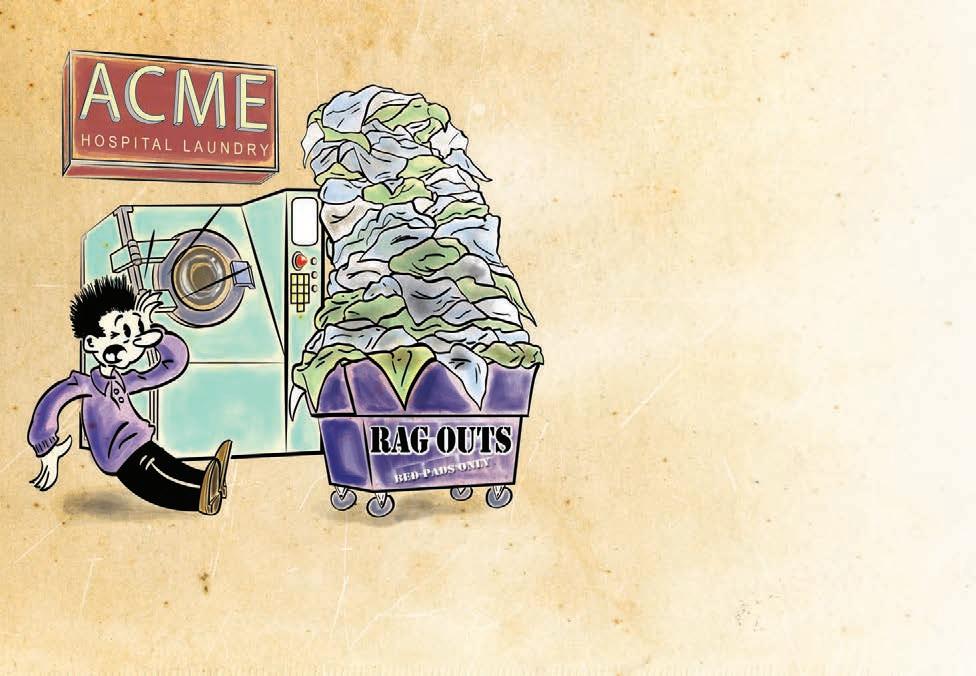
“Laundry managers are as busy as ever,” says Kovacs. “And when they work with a reputable chemical provider, there is little need, other than personal interest possibly, to become well-versed in the details of the chemistry involved in the wash process.”
But he adds that managers should at least be familiar with some basic parameters in laundry chemistry.
Knowledge transfer is key to keeping managers informed now and in the future, according to Lang.
“Overall, I would say that laundry managers understand how formulas work, but I think we all have to recognize that there’s a risk moving forward,” he says.
Minissian agrees that ongoing training is crucial for managers trying to navigate the long list of variables that can affect wash formulas.
“Today’s laundry environment is ever-changing, with sophisticated and automated advanced technology requiring [a] higher skill set and knowledge,” he says. “This is an area that demands continued education and training.” ALN
A growing number of polyurethane bonded underpads rag out too early increasing costs for the laundry. These pads are not designed to meet the demands of institutional laundries and are removed from circulation due to delamination or leaks caused in the extraction process.
Beck’s Classic Arid Touch underpads are the proven “Patient & Laundry Friendly Pad”. The face fabric provides fast wicking of moisture away from the patient for enhanced skincare bene ts combine that with Vintex’s Uniply Lite bonding process which maximizes the life of the pad. This allows the underpad to be washed with both Chlorine and Peroxide based systems, unlike polyurethane pads.
50 Emjay Blvd (p) 516-868-3200 Brentwood, NY 11717 (f) 516-868-8282 USA pads@becksclassic.com
GET BACK TO QUALITY AND RELIABILITY, ASK FOR THE BECK’S ARID TOUCH UNDERPAD UNDERPADS LAST 50% LONGER
ALN_Tab_half.indd 1 3/11/14 1:45 PM www.AmericanLaundryNews.com AmericAn LAundry news | m Ay 2014 17
continued from Page 9 wash
HCSC names Taylor Hospital’s Holobowicz Linen Coordinator of Year

RIDLEY PARK, Pa. — Ann Holobowicz, linen supervisor here at Taylor Hospital, has been named “Linen Coordinator of the Year” by Hospital Central Services (HCSC), the facility’s linen supply partner. Holobowicz, a 35-year Taylor employee, was presented with a certificate of recognition, and HCSC made a financial contribution to the hospital in honor of her accomplishments.
Bill Moyer, vice president of Marketing and Service at HCSC, says the awards are designed to recognize professionals who “go above and beyond to help encourage and promote continuing linen cost management efforts” at the company’s member hospitals. Holobowicz was among a group of 125 potential recipients for the award.
In addition to her role as linen supervisor, Holobowicz oversees supply processing and distribution for Taylor Hospital, where nearly 500,000 pounds of clean laundry are delivered every year.
Working to reduce linen losses, ensuring organized and properly maintained stock levels and serving on the linen committee for Crozer-Keystone Health System (CKHS) are among the key duties she performs in her role, according to CKHS. She also cooperates with other hospitals in the system, sharing improvements she has implemented at Taylor, including a bulk locker program to manage the distribution of scrubs and to prevent losses.
“Ann’s commitment to excellence is apparent in every aspect of her work,” says Cindy Law, RN, BSN, MBA, clinical director of Perioperative Services at Taylor Hospital, and Holobowicz’s immediate supervisor. “She is a true steward of resources and is respected by her employees, her peers and leadership throughout the system.”
Holobowicz says she was “very honored and taken aback” by the award, according to CKHS. She credits teamwork as well as her own hard work for her department’s smooth operation.
Fowler Equipment Co. earns Maytag’s highest honor
ST. JOSEPH, Mich. — Distributor Fowler Equipment Co. recently received the Fred Maytag Award during Maytag Commercial Laundry’s 56th annual meeting in Tucson, Ariz., Maytag reports.
This marks the fifth time Fowler Equipment has received the award, with its first award win dating back to 1959, accord-
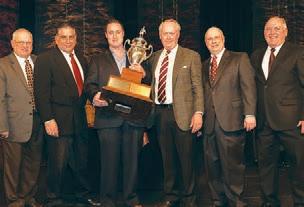
ing to Bob English, general manager at Maytag Commercial Laundry.
“Fowler Equipment Co. has exceeded all expectations as a result of unwavering perseverance, hard work and dedication. Over the years, the company has developed a loyal customer base throughout the Northeast,” says English.
The award’s primary objective is to recognize a Maytag Commercial Laundry distributor for “outstanding achievements and remarkable performance,” the company says. Recipients emulate founder Fred Maytag’s marketing philosophy to distribute the company’s products with “professionalism and integrity.”
“We are honored to receive the prestigious Fred Maytag Award for a fifth time,” says Doug Fowler, president at Fowler Equipment Co. “Our nearly six-decade partnership with Maytag Commercial Laundry is a solid foundation on which we continue to expand and grow. We embody everything this award stands for and are proud to uphold the longstanding tradition associated with it.”
World’s Greatest!... TV series features Streamline Solutions
ORLANDO, Fla. — Laundry supply manufacturer Streamline Solutions was recently featured on ION Network’s TV series World’s Greatest!..., which provided interviews, visuals and behind-the-scenes footage of Streamline Solutions’ applications and processes, the company reports.

“Streamline Solutions has been working with healthcare and hospitality laundries for many years with our products such as soiled-linen bags, cart covers and liners, along with laundry wrap,” says Streamline Solutions CEO Ross Sanders.
“No doubt, How2Media picked Streamline Solutions to be on the World’s Greatest!... TV show due to our top-notch product quality and personalized solutions approach, all to exceed each laundry stakeholder’s goals.”
Sanders adds that the company’s various products and programs “define the success of our company.”
How2Media sent a film crew to Orlando to meet with the Streamline team at the site of one of its recently completed projects. The objective was to learn the story behind the company’s “innovative, cost-saving applications.”
Mission Linen Supply adds more alternative fuel vehicles to fleet
SANTA BARBARA, Calif. — Mission Linen Supply recently increased the number of alternative fuel vehicles it uses, the company reports. Twenty-six compressed natural gas (CNG) vehicles and six propane vehicles have been added to the company’s fleet and are among its eco-conscious vehicles in use in California, Texas and Arizona.
The addition of the new vehicles has resulted in fuel cost savings and reduced emissions of nitrogen oxide, carbon monoxide and greenhouse gases, the company says.
The CNG vehicles are capable of reducing nitrogen oxide emissions by as much as 98% by burning cleaner fuel, and greenhouse gas emissions are reduced by about 30% or greater, according to the company.
The propane vehicles also burn cleaner fuel, resulting in reduced harmful emissions. The vehicles meet Environmental Protection Agency (EPA) and California Air Resources Board certification requirements.
Huebsch adds Empire Laundry Machinery to distributor network
RIPON, Wis. — Huebsch recently added Rochester, N.Y.based Empire Laundry Machinery to its distribution network in New York state, the company reports.
The authorized distributor can now provide Huebsch commercial laundry equipment to on-premises laundries and Laundromats, according to Huebsch.
“By partnering with Huebsch, our customers now have the ability to benefit from the brand’s wide range of commercial equipment featuring easy-to-use controls,” says Gerry Hendershot, president and owner of Empire Laundry Machinery.
For on-premises laundries, Empire will offer Huebsch hardand soft-mount washer-extractors with eBoost™ technology, made in capacities of 18 to 65 pounds, and commercial tumble dryers, with capacities from 25 to 175 pounds. ALN
ALN_Tab_1-4_H.indd 1 2/11/14 2:14 PM 18 MAY 2014 | AMericAn LAundrY news www.AmericanLaundryNews.com
Dean and Doug Fowler (center) of Fowler Equipment Co. accept the Fred Maytag Award during Maytag Commercial Laundry’s 56th annual meeting in Tucson, Ariz. Joining them are (from left) Dick Ruel, John Maltese, Bob English and Randy Karn. (Photo: Maytag Commercial Laundry)
Holobowicz
laundry/linen industry.

• 7-9 p.m. — Welcome Reception
Tuesday, June 10
• 8-9:15 a.m. — The day’s events open with New Business Opportunities in the LongTerm Care Market, presented by Amanda Lobb, RLLD, Calderon Textiles, and a session from Janice Larson, Encompass Group, on Understanding Linen’s Role in Value-Based Purchasing
• 9:30-11:30 a.m. — Speaker Dave Davlin leads the morning’s general session with The Playmaker Mentality
• 11:45 a.m.-1:45 p.m. — A “Lunch and Learn” event will pair cuisine from an award-winning chef with minieducational sessions, and will also include a presentation by one of ALM’s allied trades partner members.
• 2-3:15 p.m. — The afternoon’s educational breakouts will feature The Lifetime Value of a Customer, presented by Steve Kallenbach, American Dawn, and an industry update on Mergers and Acquisitions in Healthcare by Jeff Cohen, MedAssets.
• 3:30-4:45 p.m. — Paul Fayad, Positive Leader, will present Managing Staff in Times of Change in the afternoon’s second set of educational breakouts, and Glen Phillips, Phillips and Associates, will advise attendees on Developing New
Business in the Hospitality Industry

• 6:30-9 p.m. — The “Cabana Crawl,” a new event, will feature a vendor hospitality area offering refreshments, entertainment and giveaways.
Wednesday, June 11
• 8-9:15 a.m. — The final morning’s educational breakouts include The Importance of Linen Usage Tracking Systems by Glen Phillips, Phillips and Associates, while Nancy Jenkins, American Reusable Textile Association (ARTA), will present a session on Proving the Value of Reusables
• 9:30-11 a.m. — Off the Plate by Steve Kallenbach, American Dawn, and Business Plan Development for Savvy Professionals, David Bernstein, Turn-Key Engineering, are presentations slated for this time slot.
• 11:15 a.m.-12:30 p.m. — In the day’s final breakouts, Doug Vieldhouse, Pertl & Alexander, presents Building a Foundation to Thrive, and Paul Fayad, Positive Leader, gives advice on Managing a Disengaged Workforce


• 1:45-3:45 p.m. — The “Breezeway Chat” will focus on the perspectives of panelists Doug Story, David Bernstein and Glen Phillips.
• 6:30-9 p.m. — The ALM Awards and Reception Dinner concludes the event. Online registration is available until June 5. To learn more about the conference, or to register, visit www.almnet. org/?page=ALMConference ALN
Calendar


May
15 Association for Linen Management Webinar: Green Conspiracy— Saving the Environment Without Breaking Your Budget Info: 800-669-0863
20-22 Textile Rental Services Association Innovation Summit & Tours Spartanburg, S.C. Info: 877-770-9274
22 Textile Rental Services Association CEO/Executive Roundtable — F&B and Tours Greenville, S.C. Info: 877-770-9274

June
9-12 Association for Linen Management 2014 Educational Conference Tampa, Fla. Info: 800-669-0863






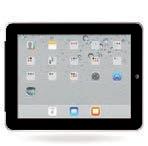
18-19 Textile Rental Services Association Third Annual Safety Summit Nashville, Tenn. Info: 877-770-9274
26 Wisconsin Fabricare Institute Annual Convention, Auction and Trade Show Mequon, Wis. Info: 414-529-4707
July
17 Association for Linen Management Webinar: Proactive Customer Service Info: 800-669-0863
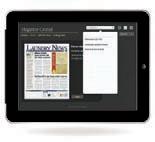


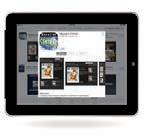
17-18 Textile Rental Services Association Sales and Marketing Summit Baltimore, Md. Info: 877-770-9274 ALN

www.AmericanLaundryNews.com AmericAn LAundry news | m Ay 2014 19 Download Magazine Central and read American Laundry News on your iPad or Android Tablet Step 1: Go to your App Store and type Magazine Central into search bar Step 3: Open the Magazine Central App Step 2: Click the box to install the app (you won’t have to do this again) Step 5: Click Download Step 6: Click View Step 4: Type AmericanLaundry News into the search bar The app stays on your tablet. Check back monthly to download the latest issue. Step 7: Read & enjoy! 0414aln_Mag Central tab half.indd 1 3/12/14 4:59 PM
ALm continued from Page 1

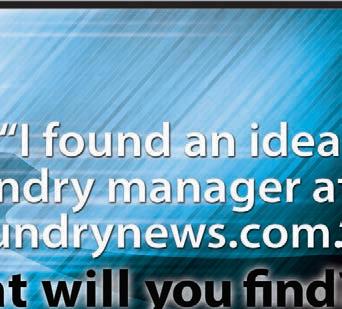







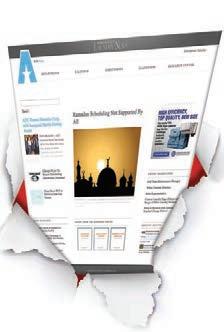









20 MAY 2014 | AMERICAN LAUNDRY NEWS www.AmericanLaundryNews.com PARTS, PARTS, PARTS
stock of parts for most laundry equipment & boilers.
traps, valves and lubricants.
delivery.
800-333-8883 Fax: 305-751-8390 parts@steineratlantic.com
Classified Advertising PARTS FOR SALE EQUIPMENT FOR SALE AMKO AMERICA, INC. Remanufactured Finishing Equipment Delta Ironers, Omega Folders & Towel Folders (1 year parts warranty) Like new at half the cost. PARTS, IRONER SUPPLIES & NEW EQUIPMENT ALSO AVAILABLE Contact: (561) 863-9696 jurgenb@bellsouth.net POSITIONS AVAILABLE DISTRIBUTOR OFFERINGS www.ineedjpequipment.com 800/925-3236 EQUIPMENT FOR SALE: CBW System CBW Mentor Control CBW Inverter Cabinet CBW Load Conveyor, 1996 10 mod CBW, 1996 Flow lifter and Splitter Tanks Single Stage Press, 2012 Incline Conveyor Milnor Shuttle, 1996 Milnor Tunnel Dryers, 1996 Milnor Tunnel Dryer, 2012 Milnor Belbox Dryer Control Cabinet Post Dry Conveyor, 1996 Tunnel Dryers Lint Collector, 1996 Conventional Dryers (2) Milnor 122D Dryers, 2005 (2) ADC Dryers, 1995 Challenge Dryer, 1980 Conventional Washers (2) 135lb Milnor Washers, 1996 700lb Washex Washer, 1990 (2) 400lb Braun TSL Washer, 1984 “Expect Excellence” Expect excellence from the leader in used industrial laundry equipment sales and installation. Keep up to date with equipment for sale, and the latest industry news by subscribing to our monthly newsletter. Go to www.ineedjpequipment and sign up TODAY! About JP Equipment JP Equipment is a trusted, full-service, used industrial laundry equipment sales and installation company. We pride ourselves on providing unparalleled Call Craig Lloyd toll free at (877) CWL-LOYD between 9 a.m. – 9 p.m. EST. Please visit www.laundrycareers.com to review current industrial/institutional laundry management openings. ADVANCE YOUR CAREER MISSED OUR DEADLINE? PLACE YOUR AD ONLINE: www.AmericanLaundryNews.com The Griffin Group, Inc. “Recruitment Specialist” Need to FILL a position? Call Deana Griffin 888-235-2365 www.thegriffingroup.cc deana@thegriffingroup.cc ® Stanco Industries, Inc. Serving The Textile Trades Since 1970 800-932-3769 k for Mike @ ext 203 KEEPING IT GREEN SINCE 1970 -------------- Equipment For Sale -------------1 2005 Braun Omega 2-Lane. L/Discharge 1 2005 Braun Omega 2-Lane. R/Discharge 1 2005 Chicago 36” 1-Roll Thermal Heated 1 2001 Chicago King Edge Spreader-Feeder 1 2001 Chicago Edge Blanket S/F 3 2003 Milnor 135# w/e EP Plus 5 2003 Huebsch 120# Gas Dryers 3 2007 Huebsch 120# Gas Dryers 1 2009 Sellers 80hp Boiler,150psi Never Installed 1 2005 Ludell 3M Direct Contact Water Htr --------- DON’T BE LEFT WITHOUT POWER -------Emergency Generators Available 50KW to 1000KW Natural Gas & Diesel Stanco Industries, Inc. 800-932-3769 Ask for Mike @ ext 203 www.StanCoInd.com QTY DESCRIPTION 1 Braun 600lb Top Side Loaders 2000 1 Braun 400lb Steam Dryer Model 123 1 Jensen 2 Roll 36” Steam Ironer 1996 2 Milnor 120lb Steam Dryers 2006 2 Milnor 36026V5J 100lb Washers 2004 2 Milnor M122 Gas Dryers 1 Chicago PikQuik 1 Chicago S-10 Skyline Folder 2000 1 Shaper Steam 12” Ironer by 120” For Pricing call Ron Hirsch 516.938.4300 • 516.315.7426 Hicksville, NY www.directmachinery.com FOR NEW OR USED LAUNDRY EQUIPMENT, DM IS YOUR SOURCE FOR ALL YOUR NEEDS We Buy Used Equipment • Pictures on website Get the info you need online... www.AmericanLaundryNews.com (1) MILNOR 2006 48040F7B 275# 2 WAY TILT OPEN POCKET SOFT MOUNT WASHER (2) B & C 2011 SP100 100# SOFT MOUNT WASHERS WITH BLUOX OZONE (1) UNIMAC 1998 UW100PV 100# WASHER 480V (1) CHICAGO 2002 IMPERIAL 232 STEAM IRONER (1) CHICAGO 2006 TRISTAR 32PCS GAS IRONER/FOLDER/STACKER (1) CHICAGO 2002 SKYLINE S-10 FOLDER (1) CHICAGO 2007 SKYLINE S-14 FOLDER/STACKER (1) CHICAGO 2004 SKYLINE BLANKET FOLDER/STACKER (1) CHICAGO 2001 EDGE SPREADER/FEEDER (1) CHICAGO 2006 AIR CHICAGO SMALL PIECE FOLDER (1) CHICAGO 1997 AIR CHICAGO XL SMALL PIECE FOLDER (1) JENSEN 1995 JET SMALL PIECE FOLDER (1) COLMAC 1997 CFS-1200SRH STEAM TUNNEL (1) HUEBSCH 2006 UD20X126 FRONT RETURN GAS IRONER (1) UNIPRESS 1998 SBT SINGLE BUCK SHIRT PRESS (1) UNIPRESS 2003 CRD ROTARY DOUBLE BUCK SHIRT PRESS View photos of entire inventory at www.washburnmachinery.com 800-245-8425 Laundry-Consulting.Com Professional laundry consulting support. New and upgraded plant designs. Process evaluation and improvement. HLAC prep. Used equipment locator services. Contact David Chadsey, 321-287-4448, dc@laundry-consulting.com. CONSULTING SERVICES
Huge
Also
Overnight
Steiner-Atlantic,
www.steineratlantic.com








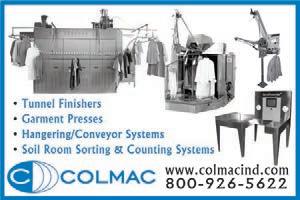






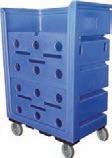
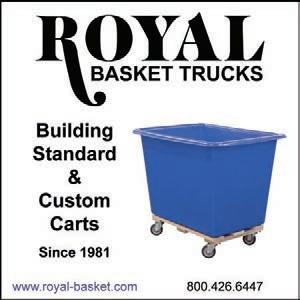
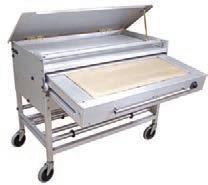






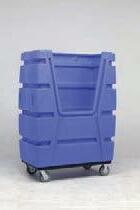
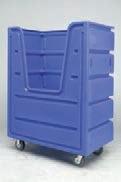



www.AmericanLaundryNews.com AMERICAN LAUNDRY NEWS | MAY 2014 21 Source Directory A convenient guide to sources of products and services APPAREL FINISHING CARTS, TRUCKS & BASKETS #1 Manufucturing Source for Laundry Transportation! (800) 634-0555 RBWire.com l-800-275-2436 RepsAvailable8 AM-8 PM (EST) maxi-movers.com Fax: 631-661-8209 •Email:sales@maxi-movers.com The Cart Guys TURNABOUT TRUCK • Simply reposition the poly shelves to convert from a clean linen delivery to a soiled linen bulk transport truck • M8594's shelf design reduces overall height by 20% for more ergonomic top loading Chm #9572 Rev. Turnabout 3" ALN Class. 3/28/14 11:23 Source Directory listings in American Laundry News are sold on an annual basis at the following rates: All Major Credit Cards Accepted 2014 Listings Regular Boldface All Caps All Caps, Boldface Four Line Listing per Year $820 $1,030 $1,030 $1,090 Display and additional line rates available upon request Sani Trux - McClure Industries, Inc. 9051 SE 55th Ave., Portland, OR 97206 800-752-2821 www.mcclureindustries.com, info@mcclureindustries.com M.I.T. POLY-CART 211 CENTRAL PARK WEST, NEW YORK, NY 10024 800-234-7659, FAX: 212-721-9022 WWW.MITPOLYCART.COM CARTS, TRUCKS & BASKETS CARTS, TRUCKS & BASKETS AmericanLaundryNews.com More than unique visitors monthly! 5,250 www.nortonsupply.com • 800.869.7664 • sales@nortonsupply.com Heavy Duty Rhino Wrapping Machine • Rhino Console Wrapper for finished laundry. • Stainless steel construction. • Solid state controlled electric cut-off rod. In-stock for immediate delivery. FREE Roll of Laundry Wrap with Rhino Wrapper Purchase Latest carts—brilliantly engineered for lighter tare weights—so consistent you can skip the weigh-in, ensure accurate billing. Staffers welcome the easy rolling, too! When You Care About Tare...Weights Call 800.829.4535 • MODLaundry.com • FREE QUOTE 72P 72S Meese Orbitron Dunne Co.
Sani Wash - McClure Industries, Inc. 9051 SE 55th Ave., Portland, OR 97206 800-752-2821 www.mcclureindustries.com, info@mcclureindustries.com
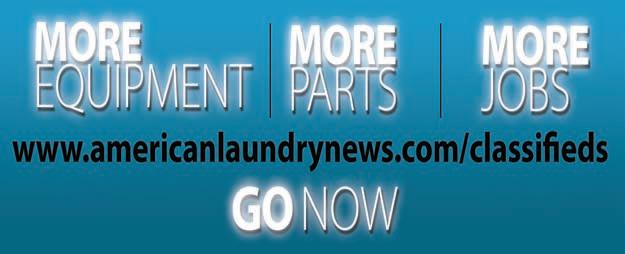
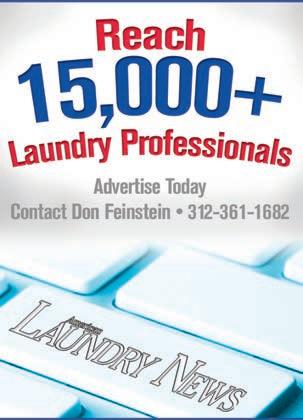



Pellerin Milnor Corp. P.O. Box 400, Kenner, LA 70063 504-467-9591, Fax: 504-468-3094 www.milnor.com







Pellerin Milnor Corp.










P.O. Box 400, Kenner, LA 70063 504-467-9591, Fax: 504-468-3094 www.milnor.com




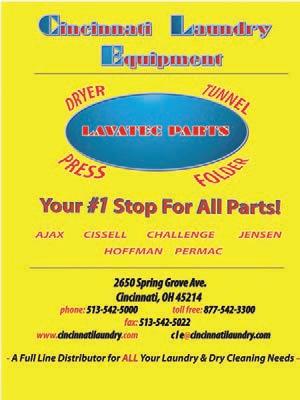
22 MAY 2014 | AMERICAN LAUNDRY NEWS www.AmericanLaundryNews.com Source Directory listings in American Laundry News are sold on an annual basis at the following rates: All Major Credit Cards Accepted 2014 Listings Regular Boldface All Caps All Caps, Boldface Four Line Listing per Year $820 $1,030 $1,030 $1,090 Display and additional line rates available upon request Gardner Machinery Corporation P. O. Box 33818, Charlotte, NC 28233 Ph.: (704)372-3890; Fax: (704)342-0758 www.gardnermachinery.com MATERIAL HANDLING / CONVEYORS FINANCIAL SERVICES Source Directory A convenient guide to sources of products and services FLATWORK IRONERS FLATWORK IRONERS Setting the Standard in Lint Filters for 25 Years • Hotel • OPL • Coin Op • Dry Cleaners • Industrial • Commercial • Cruise Industry Dry or Wet Style Filters to Work with “ALL” Dryer Sizes or Multiple Situations, Fiberglass or Stainless and Custom for Unique Situations! All manufacturing done on premise 800-826-1245 www.cleancyclesystems.com • ccsystems@tqind.com PARTS Knowhow In Action Your Tingue rep is a fully trained master of finishing equipment operation, maintenance and installation. Call for: • Pads, covers, belts, waxes, tapes and more • Carts, trucks, baskets and bags • Parts, rebuilds and repairs 800.829.3864 www.Tingue.com TalleyMachinery.com MODLaundry.com TBR-Associates.com To website LINT COLLECTORS & FILTERS ★ Our In-Line Lint Filter mounts inside, saves space! ★ Fiberglass Wet Filters - 6,000 to 40,000 cfm ★ Fiberglass or Stainless Steel Dry Filters ENERGENICS CORPORATION Talk with our Design and Engineering Staff about your needs. Hundreds Sold Annually. 800-944-1711 www.energenics.com (480) 205-1293 (602) 763-7416 www.azsle.com Whether your ironer needs pads and covers, wax cloths or cleaning supplies, or needs to be completely rebuilt, there is no job too big or too small for Southwest Laundry Equipment • Financing of all OPL, industrial and related equipment • Competitive rates • Flexible terms • No prepayment penalty 1-800-851-1001 ext. 209 | laundry@firestonefinancial.com www.firestonefinancial.com EQUIPMENT FINANCING COMMERCIAL & INDUSTRIAL FINANCING Energenics
Kartwasher
Corp.,
1470 Don St., Naples, FL 34104 800-944-1711 www.energenics.com
DRYERS – 100 POUNDS OR MORE CART-WASHING SYSTEMS
DRYERS – 100 POUNDS OR LESS
Pellerin Milnor Corp.
P.O. Box 400, Kenner, LA 70063 504-467-9591, Fax: 504-468-3094 www.milnor.com
WASHER-EXTRACTOR




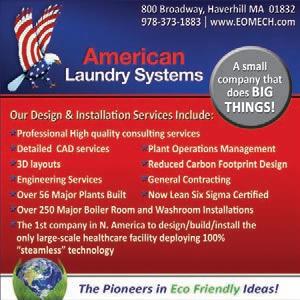
Pellerin Milnor Corp.
P.O. Box 400, Kenner, LA 70063 504-467-9591, Fax: 504-468-3094 www.milnor.com
Pellerin Milnor Corp.




























P.O. Box 400, Kenner, LA 70063 504-467-9591, Fax: 504-468-3094 www.milnor.com






www.AmericanLaundryNews.com AMERICAN LAUNDRY NEWS | MAY 2014 23
– 100 POUNDS OR MORE
WASHERS – CONTINUOUS BATCH WASHER-EXTRACTOR
– 100 POUNDS OR
LESS
Milnor Corp. P.O. Box 400, Kenner, LA 70063
PRESSES – EXTRACTION Source Directory A convenient guide to sources of products and services PLANT DESIGN & INSTALLATION Source Directory listings in American Laundry News are sold on an annual basis at the following rates: All Major Credit Cards Accepted 2014 Listings Regular Boldface All Caps All Caps, Boldface Four Line Listing per Year $820 $1,030 $1,030 $1,090 Display and additional line rates available upon request Company Web Site Page Company Web Site Page INDEX OF ADVERTISERS www. .com A.L. Wilson Chemical Co. www.alwilson.com 13 American Dawn www.americandawn.com 5 Beck’s Classic www.becksclassic.com 17 Direct Machinery Sales Corp. www.directmachinery.com 20 EDRO Corp. www.edrodynawash.com 18 IPSO www.ipso.com 11 J.P. Equipment www.ineedjpequipment.com 20 Kannegiesser USA www.kannegiesser.com 9 LaundryCareers.com www.laundrycareers.com 20 Lavatec Laundry Technology www.lavatec-laundry.com 24 LG www.lgcommerciallaundry.com 3 McClure Industries www.mcclureindustries.com 16 Parker Boiler www.parkerboiler.com 16 Royal Basket Trucks www.royal-basket.com 14 Stanco Industries www.stancoind.com 20 The Griffin Group, Inc. www.thegriffingroup.cc 20 UniMac www.unimac.com 7 Washburn Machinery www.washburnmachinery.com 20 THE WIRE The latest news, straight to your inbox, 2X a week A & B WIPER SUPPLY You’re probably not getting enough for your linen discards! We pay TOP DOLLAR for your discarded sheets, towels, thermal & flannel blankets. Call us for an immediate quote: 800-333-RAGS (7247) We’re Hiring! Textile Buying & Sales Executive Positions Available E-mail Résumés to resumes@bestrags.com RAGS WANTED FOR CASH OR TRADE
Pellerin
504-467-9591, Fax: 504-468-3094 www.milnor.com
